User:Leszekj
Contents
- 1 Program structure
- 2 Introduction
- 3 Basic Features
- 4 Minimum requirements
- 5 Application installation
- 6 Starting application
- 7 Application structure
- 8 Supporting messages and calls
- 9 Configuring Slican PBX
- 10 Use cases examples
- 11 Installing beta version
- 12 --------------------------------------------------------------------------------------------------------------------------------------------------------------------------------------------------------------------------------------
- 13 Program structure
- 14 MessengerCTI.Desktop for Call Center agents
- 15 Licensing
- 16 One user and few different numbers
- 17 Ports and protocols
- 18 Operation of MessengerCTI.Desktop in local network and outside network without changing configuration
- 19 ---------------------------------------------------------------------------------------------------------------------------------------------------------------------------------------------------------------------------------------
Program structure
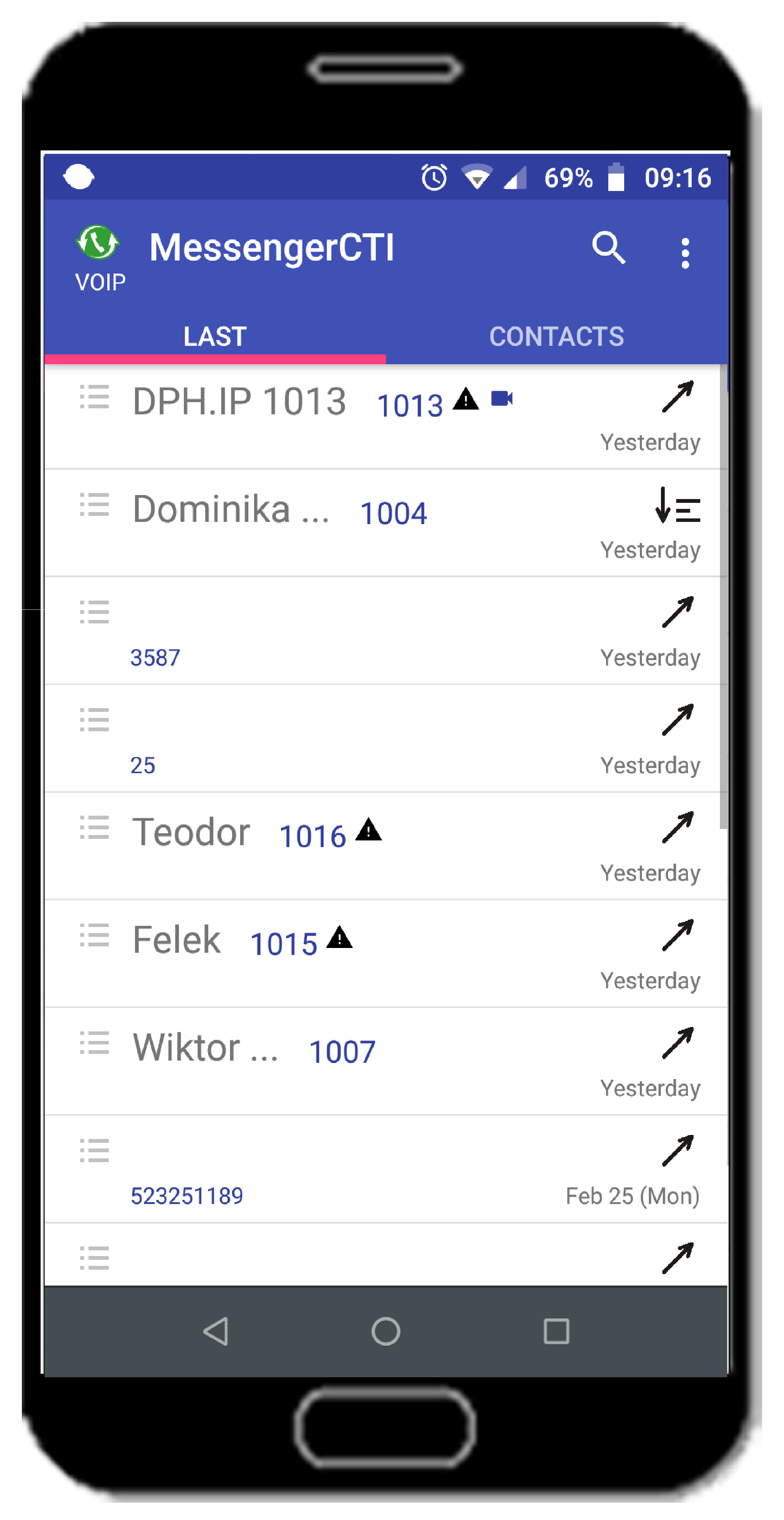
Introduction
MessengerCTI.Mobile Slican Software is mobile application dedicated for Android operating system. It integrates smartphone, computer and subscriber's desk phone. MessengerCTI.Mobile allows users making and receiving calls as PBX subscriber, transferring calls to another subscriber, using contact book, history of calls, conducting chat and text conferences, viewing phone and MessengerCTI status of other subscribers and transferring files. Video image preview function is available for PBX that support DPH.IP doorphones equipped with camera. Application supports calls related to Call Center queues - PBX subscribers/ agents are mobile and independent of their permanent workplace. Functionally, MessengerCTI.Mobile is fully synchronized with MessengerCTI.Desktop, so regardless of version used (mobile, desktop) it always ensures work with up-to-date data.
Application advantages
- handling voice calls in VoIP mode both via GSM operator's Internet network (LTE, HSPA) and WiFi network
- handling voice calls in GSM mode
- chat and text conference
- voice conference
- access to contact book with preview of other subscriber's availability status (chat, phone status, description, application)
- creating favorites group
- history of recent calls / chats - sorted chronologically
- full synchronization with MessengerCTI.Desktop application
- possibility to copy text from / to chat
- flexible configuration of sound and vibration notifications with possibility of using schedules
- access to configuration of selected PBX services (FWD, DND)
- quick reference numbers for fast call transfer
- ability to set desk phone busy if user's smartphone is busy (enabled by default)
- rejection calls on user's GSM smatphone if desk phone is busy
- ability to use DualSIM smartphones or two phones at same time (business and private)
- convenient door opening in case of calls from DPH.IP doorphone (from application connection window, contact context menu or desktop widget)
- automatic notification delay mechanism MessengerCTI.Mobile if subscriber is active on desk phone or on MessengerCTI.Desktop application
- ability to copy contacts from PBX contact book to local smartphone book
- sharing your own location
- ability to transfer files (drag & drop)
- handy clipboard for sharing data between mobile and desktop application
- available in Google Play store (free)
|
Basic Features
Using smartphone, application user gains mobility and still has option of using PBX as internal subscriber.
VoIP and GSM client
- MessengerCTI.Mobile - parallel telephone, associated with equipment of desk phone (FXS, CTS, SIP). Application can work as VoIP or GSM client. User decides on which device to answer call and make call - by desk phone or smartphone. Novelty is possibility of using application as standalone telephone in NCP (from firmware version 1.11). CTIuserPlus license is required for its correct operation.
- Configuration in VoIP mode - basic configuration for using application. Both calls made and other information, e.g. about the caller's number, contacts in book, subscriber status, chats - are sent over IP network (WiFi, LTE/ HSPA Internet)
- Configuration in GSM mode - it is most often used if access to IP network or Internet in given location is weak (insufficient for VoIP calls) or unstable. All information and signaling - are still sent via IP network (WiFi, LTE / HSPA), but calls themselves are carried out by GSM operator. With poor IP transmission quality, you should take into account that information may not always be displayed.
Switching between VoIP and GSM mode can be done by user from application configuration (if PBX is properly configured).
Phone Book
Big advantage of software is simple and convenient access to contact from phone books and displaying them on computer screen. MessengerCTI.Mobile can use only phone books from PBX. Contacts can be sorted according to user needs. Adding new subscribers and modification of existing entries can be done from CTS system phone or more conveniently, by using computer with MessengerCTI.Desktop or WebCTI. Modification of entry is visible instantly after adding it. Access to phone book allows to simply search numbers of contacts user want to call. On other hand, during incoming calls computer displaying will be showing clear information about calling person.
Call History
User has access to complete history of their calls, picked up and missed one. History is saved on Slican PBX. By using Messenger.CTI history can be displayed alongside information about order, time of calls and number of missed calls from particular number.
CallCenter (NCP PBX)
In conjunction with NCP for Call Center agents, queue handling functionality has been introduced. It allows agents to log in to them, view status, call back lost and abandoned calls, and turn on status of temporary work breaks.
Text messages
By MessengerCTI text information can be sent, from internal messenger (chat) through computer network to another person with MessengerCTI.Desktop or MessengerCTI.Mobile. Chat can be used by all subscribers of given PBX and other PBX linked with eSSL ver.2 system. This functionality is especially attractive for those companies which, having Slican PBXes, do not allow use of public communicators for security reasons. To ensure parallel access from various devices (computer, smartphone), chat history is saved directly in PBX and synchronized with MessengerCTI applications on ongoing basis. An extension of this functionality is possibility of conducting chat with many users simultaneously, i.e. so-called text conference.
Text and voice conferences
Functionality that allows to PBX messages / talk simultaneously with many users
Uploading files
It is possible to send files, e.g. photos, documents, between users of MessengerCTI application (desktop, mobile)
Location sharing
Due to mobility - user can turn on selected people observation of his location. Authorized person gains ability to observe its location.
Using cameras and DPH.IP doorphones
Introduction to sale of DPH.IP doorphones that include cameras allowed to solution that allows display of video from these cameras. Functionality was added with MessengerCTI.Mobile. While connecting to doorphone from software video from camera will appear in new window on computer display. After starting call and next finishing call, even after without talking to person standing beside doorphone, just after visual check user can open door, gate, barrier using dedicated button. Reverse is also true, calling to doorphone or another telephone associated with camera, computer display will show video from their cameras. This allow for temporary observation of neighborhood of installed camera, for example person we are calling. There is also option of watching video from any camera without making call, just using application icon. Thanks to MessengerCTI.Mobile user can preview video from camera of other manufacturers, but those devices have to support video formats, codec compatible with VLC application libraries.
Works with desktop version
Application can be used alongside and synchronized to MessengerCTI.Desktop, that is version for computer with Windows.
Minimum requirements
MessengerCTI.Mobile application is freely available - it can be downloaded from Google Play store..
For installing application minimum requirements must be met:
- Android operating system
- minimum version: KitKat 4.4.4
- minimum recommended version: Nougat 7.0
- PBX and application must have access to internet
Phone with lower version of operating system then 4.4.4 won't be able to install application.
|
|
Application installation
MessengerCTI.Mobile usage is licensed do purchasing of proper license is required. Purchased serial code is used during PBX configuration, serial code defines number of users that are able to use application. Application licensing doesn't interfere with installation. After installing application, it must be configured for connecting to PBX: Settings --> Account (described below).
During installation, you are prompted to provide some permissions. You can approve all of them or select only those related to functionalities that will be used:
- Camera - for scanning QR code and taking and transferring photos
- Location - to share your location
- Microphone - for making VoIP calls
- Internal memory - for saving photos, transferring files and using clipboard
- Phone - for using application in GSM mode
- Contacts - for copying contacts to local phone database (used only in some versions of application)
|
Starting application
MessengerCTI.Mobile application runs just like any other application working on Android operating system. During startup application is logging to PBX (according to setting from Settings --> Account tab). After successful login synchronising between application and PBX starts (call history and chat history).
Configuring application
For proper communication between application and PBX, CTI account information and other functions must be configured properly. Configuration menu is placed in bottom left corner of application window. From drop down menu Settings menu can be chosen.
Fields required for configuration can be found here: account, notifications, handy numbers.
Settings
Account
Configured with information configured by PBX administrator:
- Your telephone number: internal subscriber number (extensions) with access to CTI communication
- Password: CTI user password
- Host: port: domain or public IP address of PBX for users outside network or private IP address for users of local network, signaling protocol port: port for communication with PBX - by default TCP 5529
- Transmission encoded: XML Protocol Encryption
- Self-signed certificate
- Read data from QRCode: instead of manual configuration - ability to scan QR code sent from NCP to user's e-mail box when configuring CTI settings or from WebCTI website
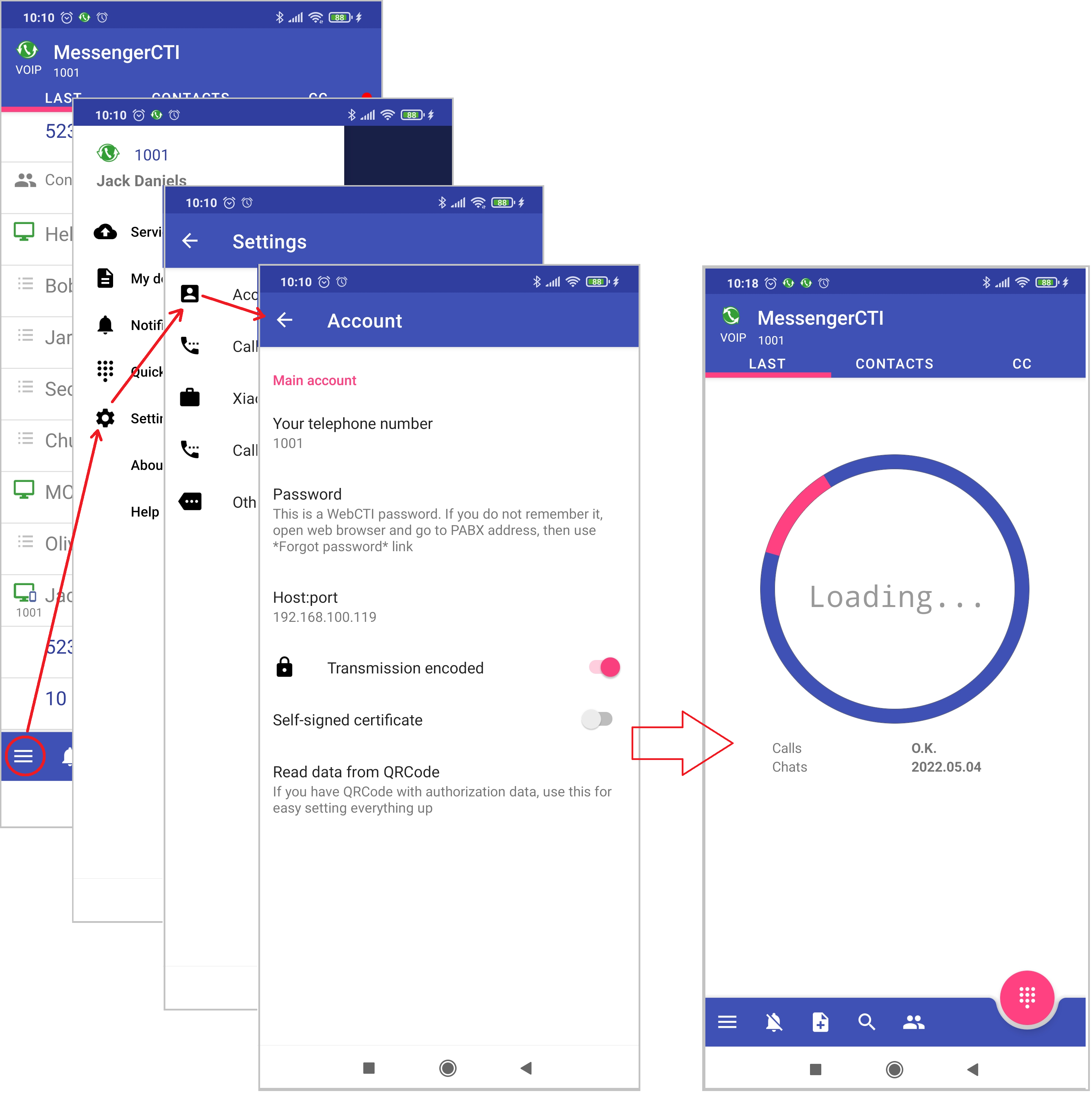
Using QRcode from WebCTI -> My subscriber account or link to code sent to user's e-mail address (only in NCP PBX with configured e-mail client)
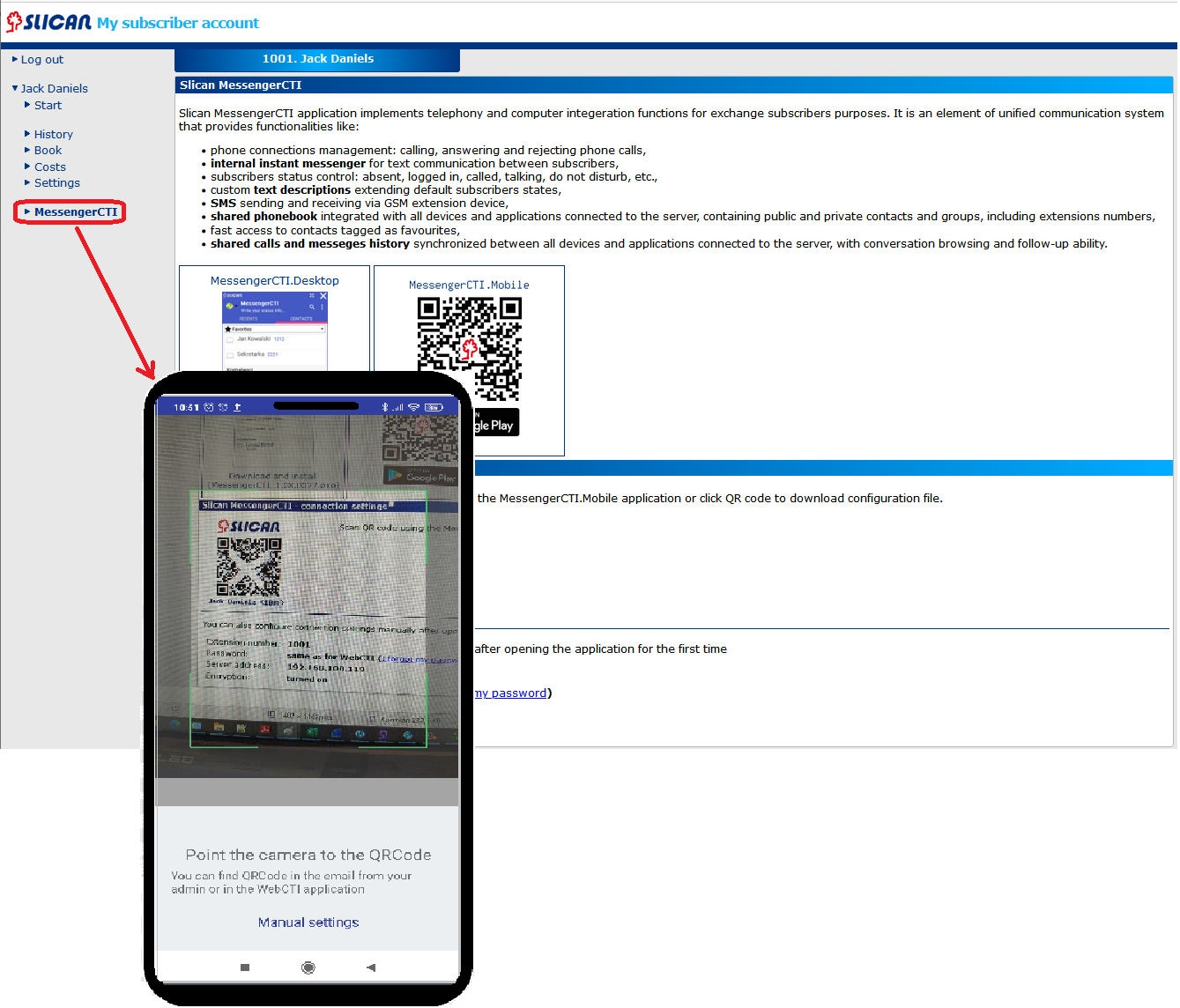
Calls
Options for activating headset button and microphone gain level
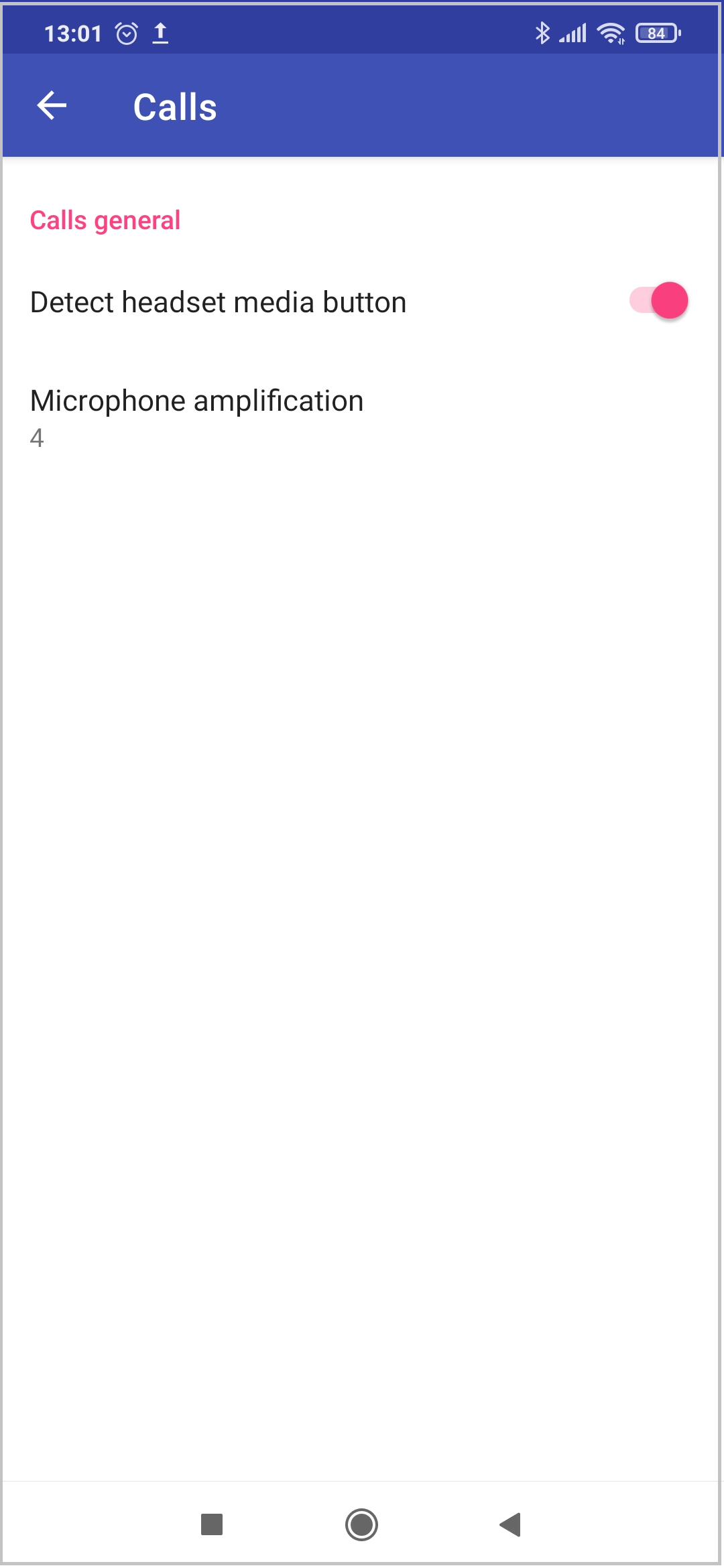
Call Center
Possibility to activate up to 4 login/ logout buttons and agent breaks related to Call Center queues
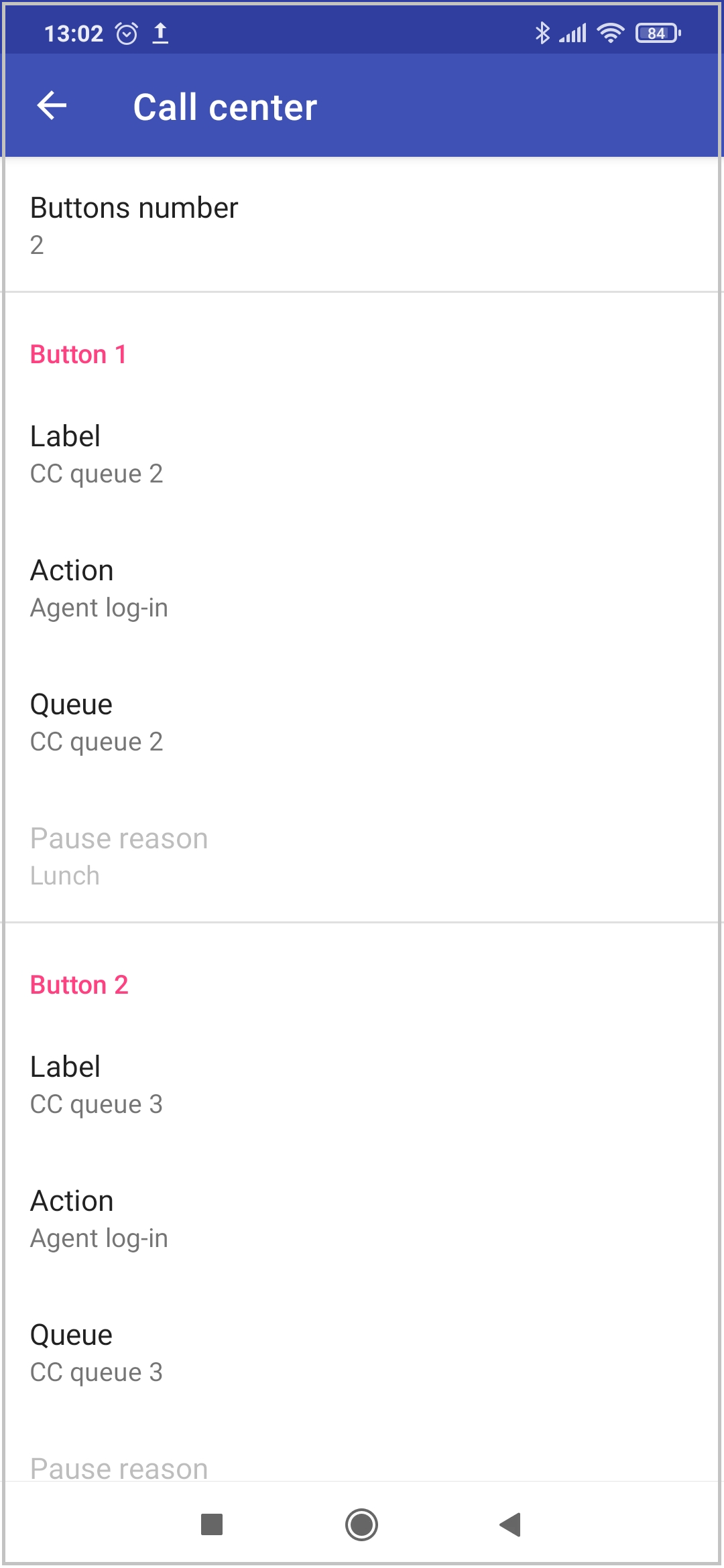
Other
Pozostałe ustawienia aplikacji widoczne są na załączonej grafice.
Debug option - turned on at request of software vendor (Slican) - is related to solving problems with correct operation of application
Enabling option causes that in tab About additional field appears Send logs via email. We choose e-mail client from which we will send application logs for analysis on Slican side.
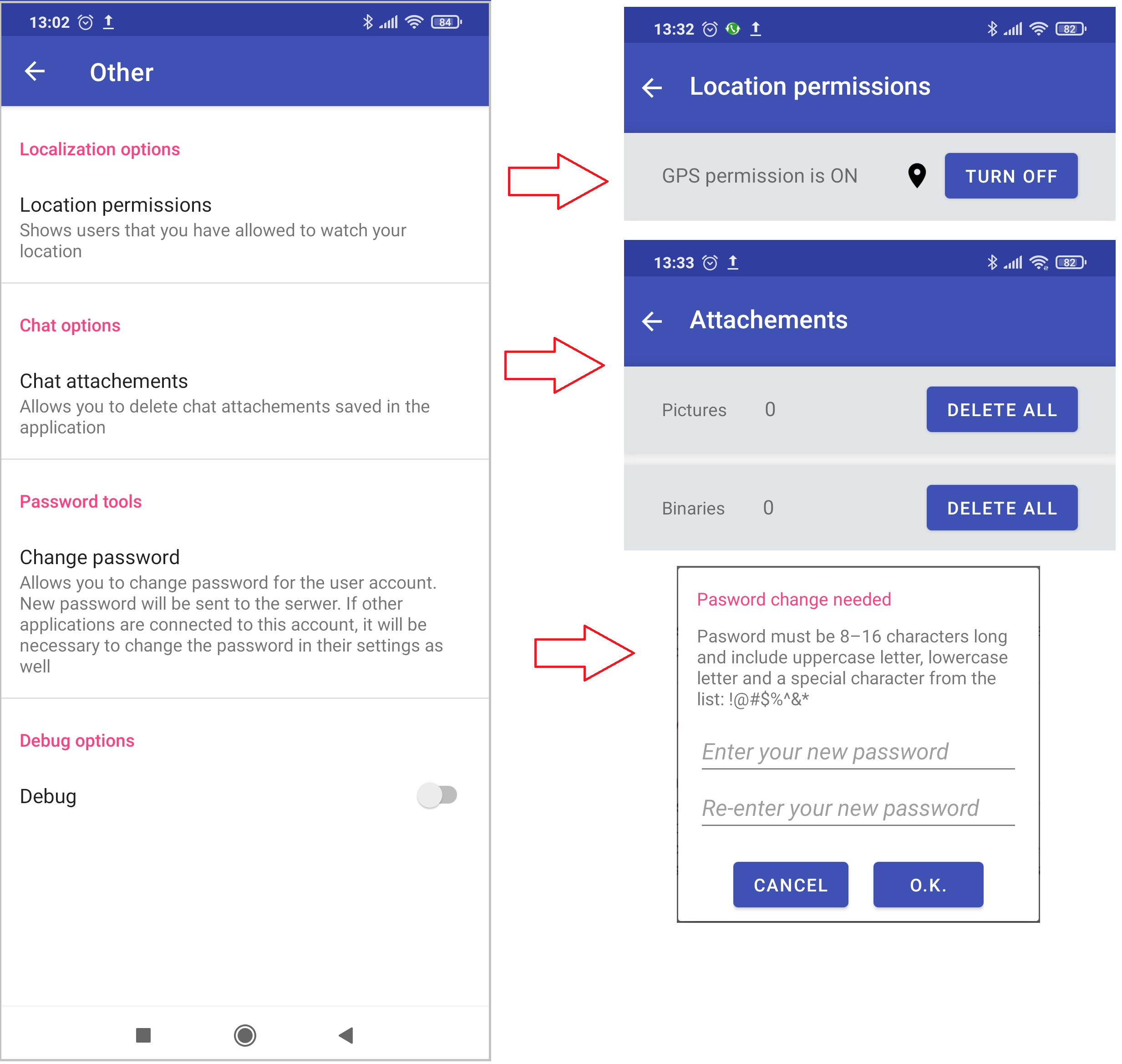
Services
Calls services configuration:
- Default connection type - settings for making calls via GSM, VoIP or VoIP over WiFi
- Global services for PBX:
- DND - do not disturb
- busy settings:
- desk phone if user is talking on GSM phone
- FWD - call forwarding settings: all, busy or no answer
My desription
Setting your own comment, which will be visible to other users of MessengerCTI application (desktop and mobile) and on screen of CTS-330 system phone
Notifications
Configuring incoming call notifications:
- ringtone: selecting one from list available in application with option to mute it after specified time
- vibration when ringing
- notification on bar about missed call
- notification schedule for call ringtone - set weekly active use plan (turn on ringing at certain times)
Configuring chat message notifications:
- message tone: selecting one from the list available in the application
- vibration on message
- notification on bar of new chat message
- message notification schedule - set weekly active use plan (enable notification at certain times)
Notification delay:
This functionality allows MessengerCTI.mobile ringing signal to be delayed by 15 seconds compared to ringing of associated telephone (usually desk phone).
After starting MessengerCTI.mobile - desk phone and application will ring simultaneously during incoming call. If we are first to answer desk phone, application will "remember" that we are nearby and will delay its ringing during next call.
It ceases to apply when:
- we will not answer call
- we will pick up call with MessengerCTI.Mobie
Handy numbers
List of handy numbers available during active call, they can be user for fast forward to another number from handy list.
Other
Configuring phone busy status depending on incoming call direction(GSM or CTI call):
- during GSM talk, internal number will be busy
- reject GSM when internal number is busy
Solving issues with proper software operation:
- debug - administrator option which is turned on on software vendor suggestion, for analysing issue logs.
After turning on debug option additional Send logs field will appear in main menu. After choosing e-mail client, application logs will be sent to software manufacturer.
Services
Configuring application services related to connections/calls:
- DND: Do not Disturb
- forwarding calls:all will be forwarded to chosen number when busy or doesn't answer(must be noted that at first number is given, then forwarding happens)
- silence application: silent mode
My description
Setting text status that will be visible to other MessengerCTI.Users or on screen of CTS-330 system phone.
About software
Information about:
- current software version
- type of connected PBX
- PBX firmware version
- Own number: CTI account number(internal PBX extension)
- Own comment: user comment made by administrator
Updating application
Application is applying updates automatically, user can set on or off automatic updates in similar manner to other Google play store applications on phone. If new softwar version will be available in Goole Play store it will automatically download or notify about recent version.
Application structure
Main window
Main application windows give access to two tab:
- Last/Recent - history of calls, chat messages and users statuses.
- Contacts - access to PBX phone book with sorting options:favourites, internal, external.
- login icon status with text status
- searching contacts
- applications settings menu
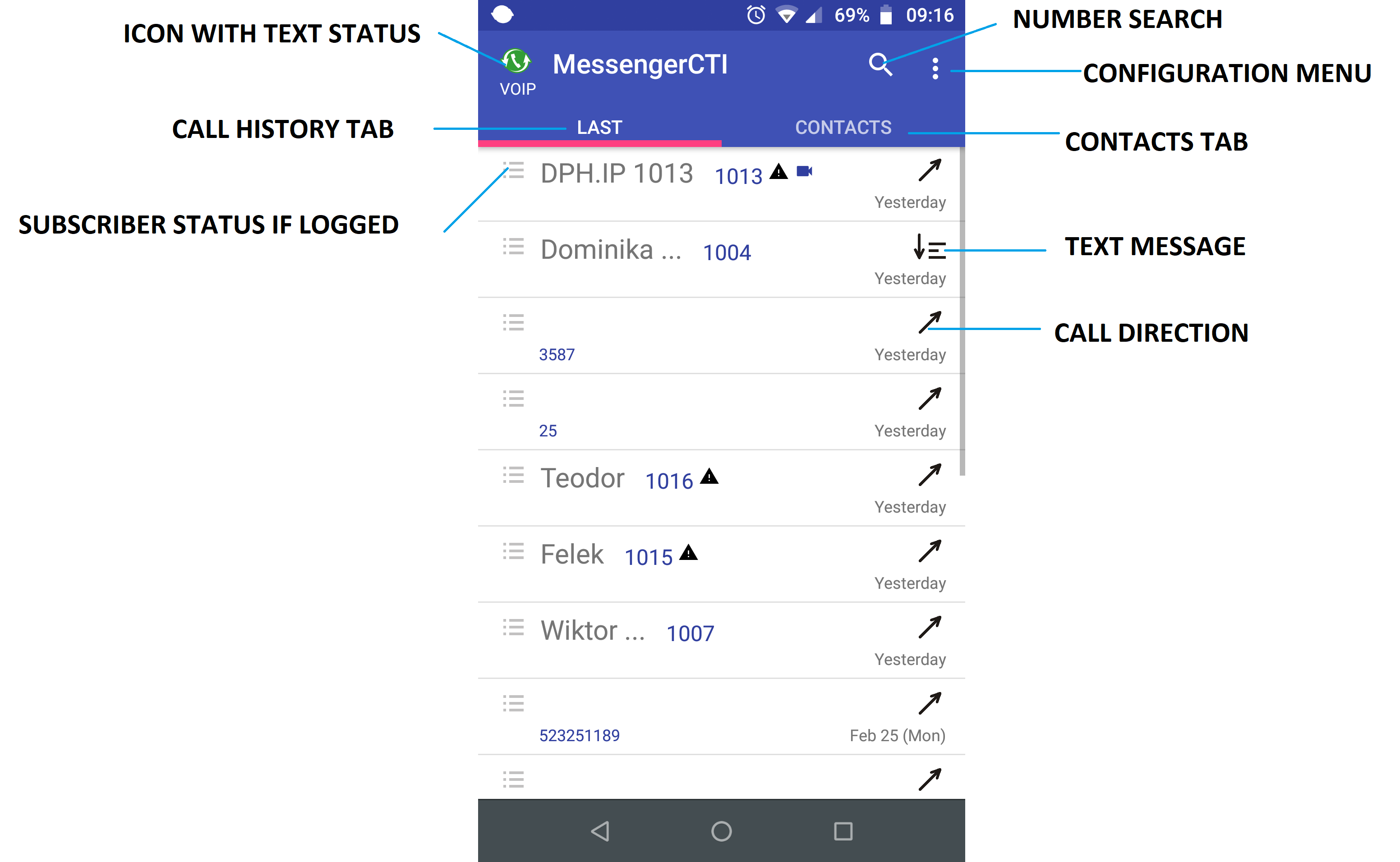
Icons meaning
MessengerCTI.Mobile gives users intuitive preview of telephone status with seperate icon for every contact or call history event. These icons allow to chose action, check call status or inform about error/issues.
Icons and symbols
"Last/recent" starting application windows is showing history of calls. Icons located here are:
- left side: application status of other MessengerCTI.Desktop/Mobile users or call history
- right side: information about call direction and message status
Table 1 describes meaning of particular icons informing about application status of other MessengerCTI.Desktop/Mobile users:
- PBX internal subscribers - icons showing status of logged application, touching icon allows to start chat or check call history
- DPH.IP doorphone - door position, touching icon allows to check history
In case of phones being PBX extensions, icon will show phone status.
| Ikona | Icon meaning |
|---|---|
| number is busy | |
| calling number or making outgoing call | |
| number is not available or faulty | |
| DND service is on |
Table 3 shows meaning of icons displaying calls status:
| Icon | Icon meaning |
|---|---|
| incoming call | |
| outgoing call | |
| new missed call | |
| missed call |
Table 4 shows icons displaying message status:
| Notification | Meaning |
|---|---|
| No connection: check network connection | |
| Wrong login or password: check account settings | |
| App not allowed in PBX: contact PBX administrator |
Table 5: Error icons meaning.
Supporting messages and calls
For call between two users necessary are:
- proper account configuration of application and PBX
- full connection between application and PBX(full data synchronisation of application with PBX) - application icon should have green color
- installed Slican system phone, VoIP or analog phone for IPx, MAC or NCP PBX or configured MessengerCTI subscriber((only NCP PBX)
Making calls
Two ways of making calls:
- from Contacts tab - choosing subscriber from particular group (if applicable), or from "All contacts" group. Call is made by touching contact tab, then choosing icon from drop down menu.
- from Contacts tab- searching for phone number in Search field by using keyboard then touching lower right corner of keyboard
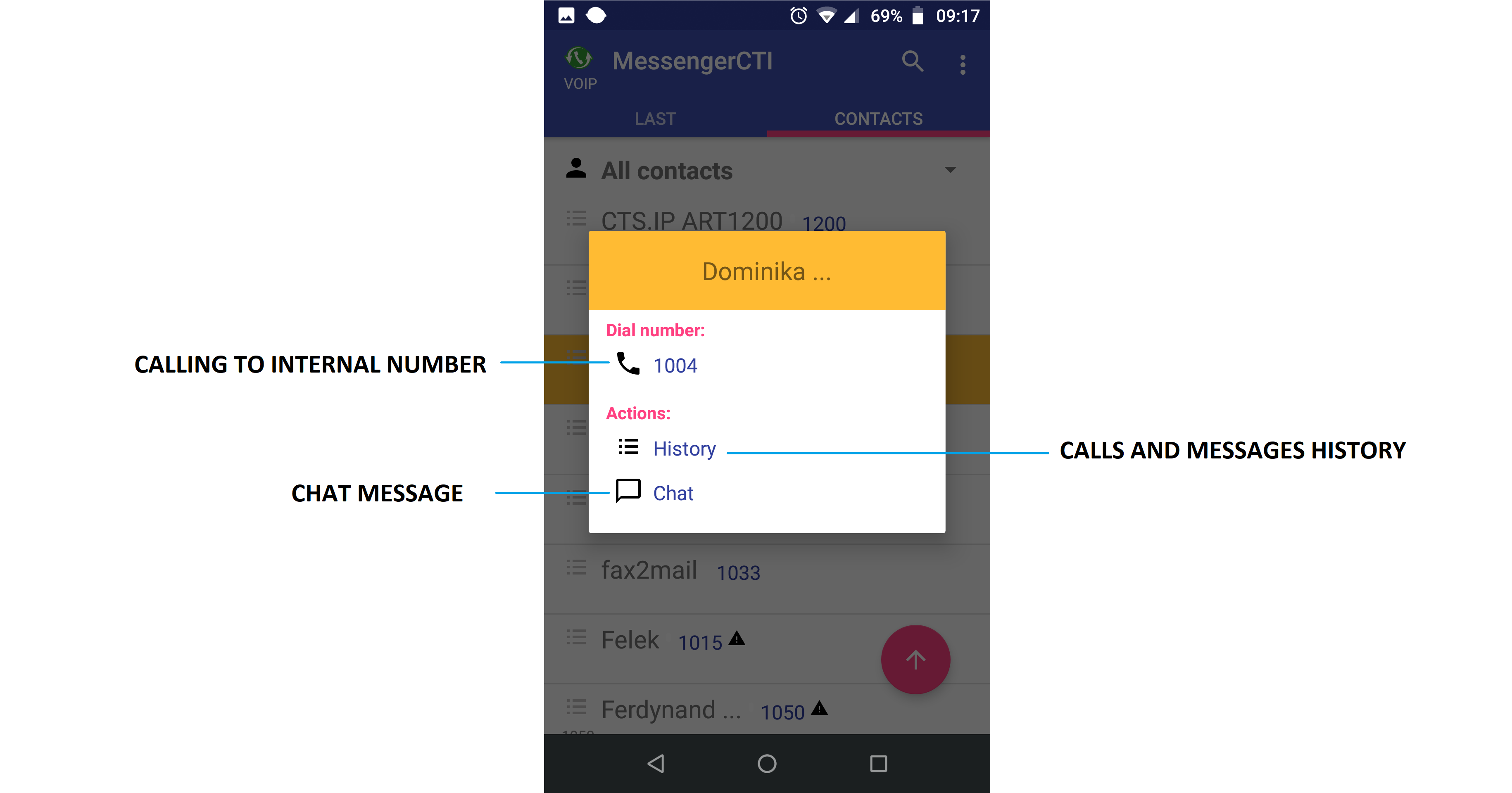
- from Last/Recent - find subscriber which we had shared call(he called or we called him) and then make call by touching middle part of contact tab and choosing action from drop down menu
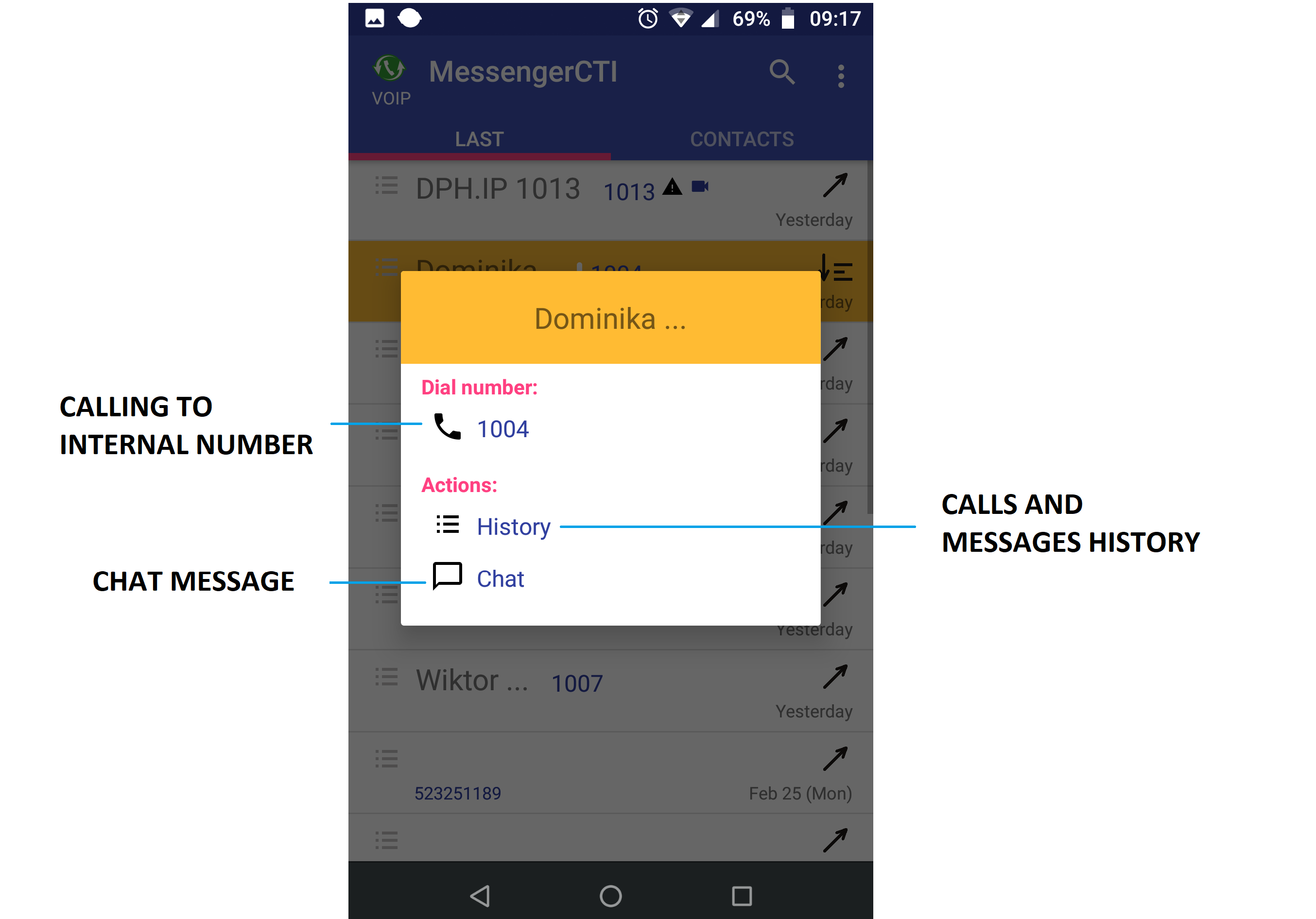
Connecting calls are displayed with call screen just like calls made using GSM. Application at first is connecting call to PBX dedicated number for MessengerCTI.Mobile users, configured by PBX administrator. Then PBX is connecting by transit to number chosen by MessengerCTI.Mobile. Due to that reason, required city line for PBX must be at least ISDN BRA.
Incoming calls
Incoming calls are displayed with popping up call window and ring tone configured in application notifications settings. Calls are received by sliding icon with green handset, if we want to reject call it can be done with sliding red handset. If additional handy numbers were set, call may be forwarded to them by sliding icon with handy number. Process of receiving incoming calls works by making a return call with GSM line to application access number defined by PBX administrator.
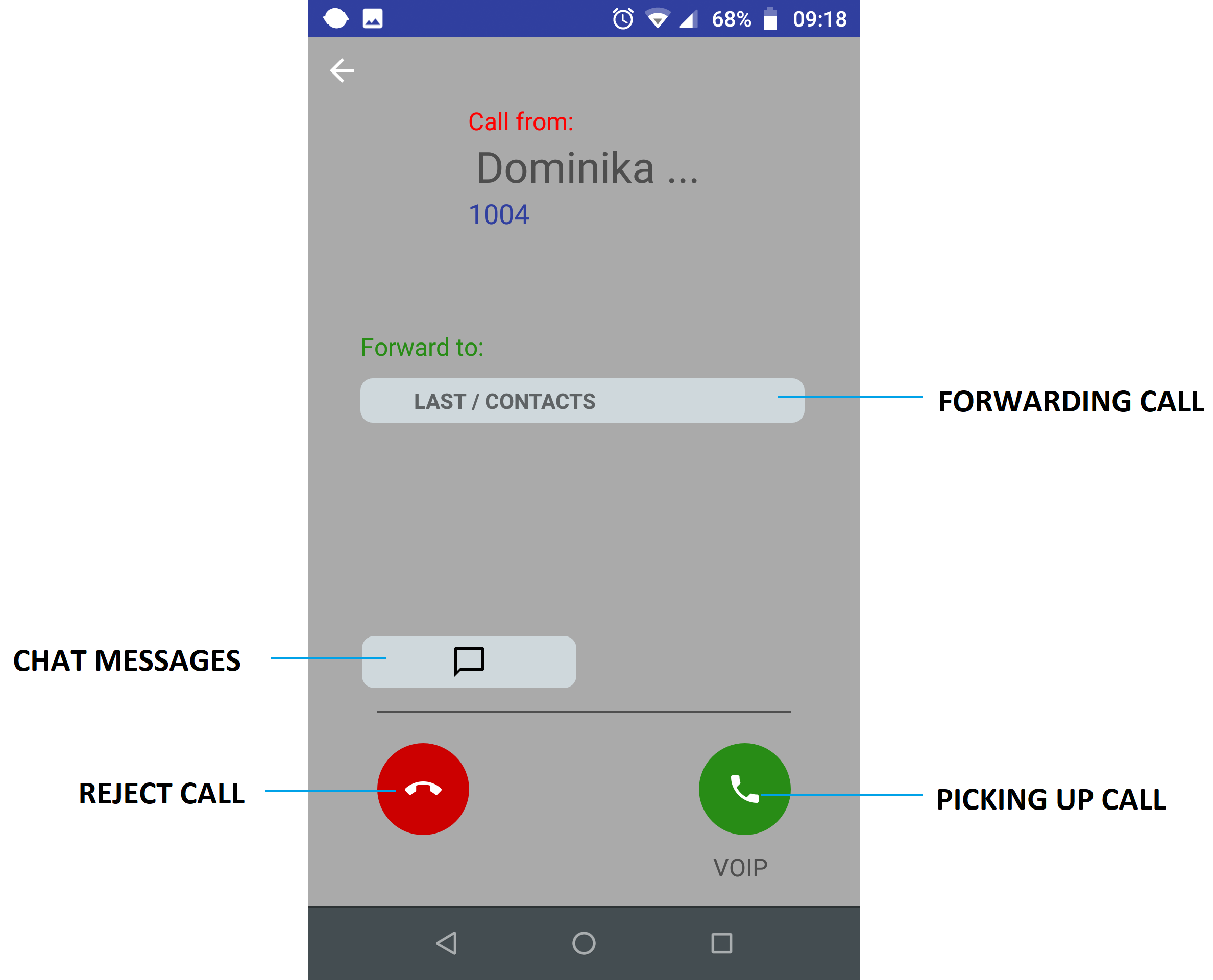
Missed calls are displayed with icon ![]() . Going to call history or calling back will clear information about amount of missed calls.
. Going to call history or calling back will clear information about amount of missed calls.
Messages support
Application allows to send and receive text messages between MessengerCTI.Desktop/Mobile user (internal chat). To send message user status icon must be touched or from drop down menu and touching contact tab, then choosing chat.
Receiving messages is displayed on notification bar by proper icon and defined ring tone.
If subscriber is using both versions of MessengerCTI, messages history is stored locally in MessengerCTI.Dekstop application.
Below is example of chat window:
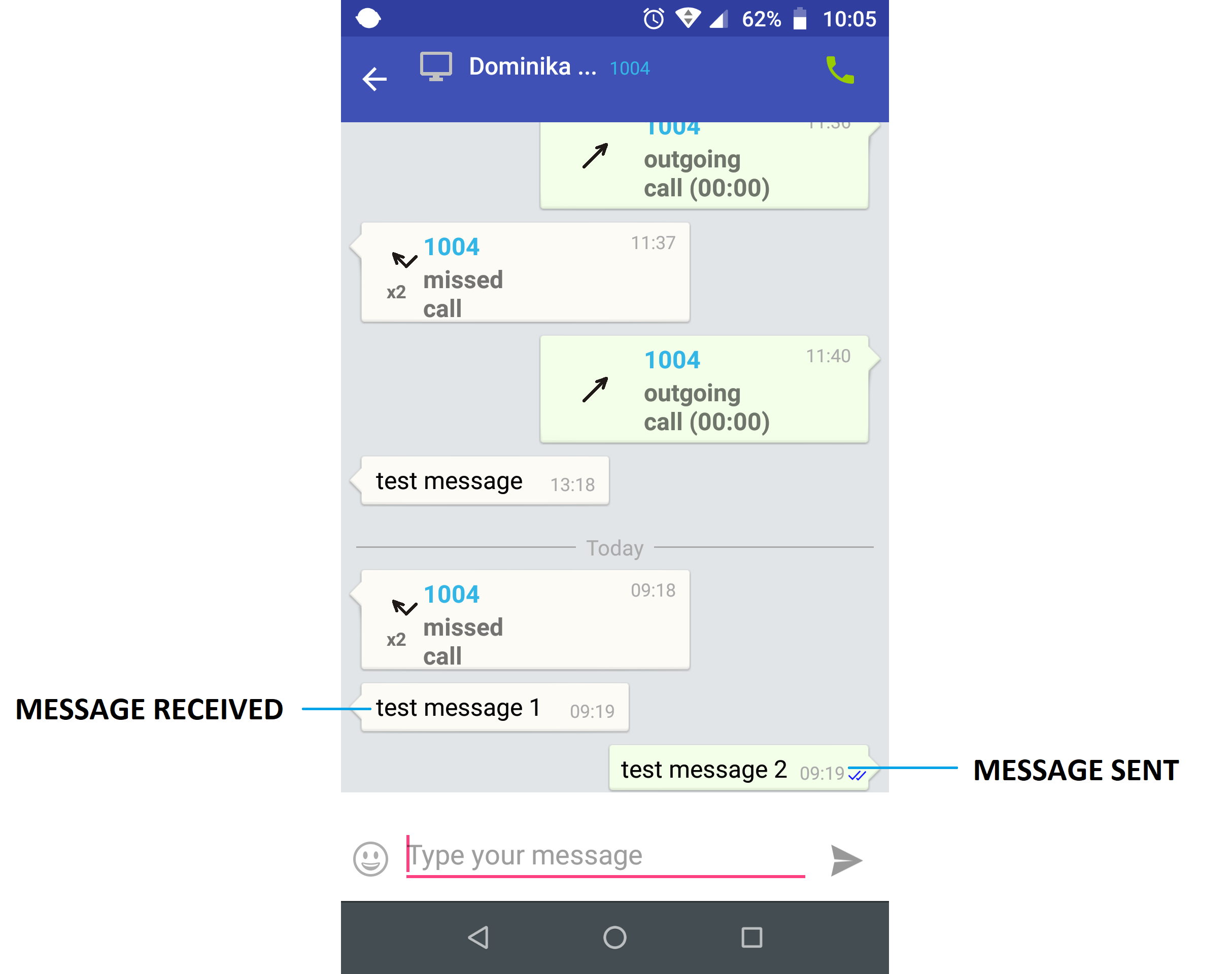
Contacts
Contacts tab allow to display and search for actions related to particular contacts. Numbers from other groups can be accessed from drop down contact list grouped as:
- favourites
- all groups
- all contacts
- internal
- external
- private
By default Favourites group is visible.
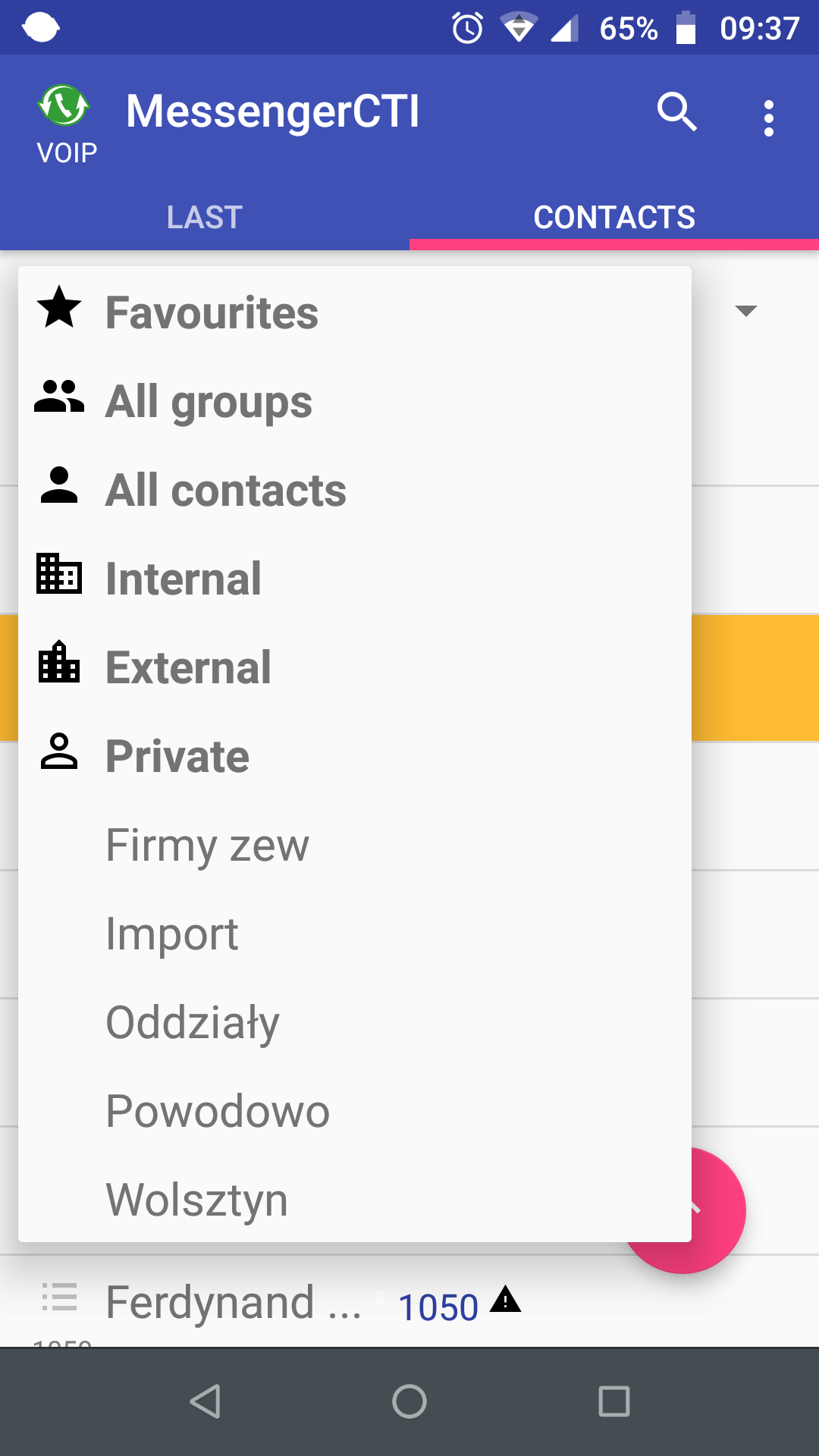
Call history
By default Last/Recent tab will be visible and showing calls and chat messages history.
In history every position is at least one call or message. If there is more then one call/message and they come from sam user, on their icon number will be displayed. Every position is displaying caller number, commentary(if number is from phone book outside PBX), time and date of call.
If in history there are missed calls or messages, Last/Recent field will be marked with red dot.
History tab allows to call back or reply to messages.
Configuring Slican PBX
For proper communication between application and PBX are required:
- correct manufacturer license
- specific PBX configuration
IPx, CCT PBX configuration
With ConfigMan software:
- Inside Themes tab and then Global settings->Global settings/Remain:
- ANo:configure access number that application will chose for making call to PBX and setting up incoming call
- Adr - public host name or PBX IP address for connecting to application(for VoIP calls with application)
- Inside Subscribers menu, Tables then Subscribers->Subscribers/CTI settings:
- AwdMbl: allow access to MessengerCTI.Mobile application
- AwdGSM: allows to connect phone calls through GSM network
- IncC: setting up method of how application connects incoming calls:
- Call pickup - picking up incoming call with application means making outgoing call with GSM phone to number from 'ANo field inside Global settings/Remain
- Parrallel calling - incoming calls to GSM phone from number set in ANofield inside Global settings/Remain
- MnNo: configure GSM phone access number, on which application is installed, optionally configure second number(for dual SIM phones)
- SecNo: second GSM phone number with installed application(optional, for dual SIM phones)
For application to work with each settings, these fields parameters must be set:
- VoIP network: 1.2, 2.1
- GSM network: 1.1, 2.1, 2.2, 2.2.1, 2.2.2, 2.3 and 2.3.1 or 2.3.2
Minimum PBX firmware version - 6.53, for VoIP - 6.54
NCP PBX configuration
From ConfigWEB application:
- Extensions->Settings->CTI application settings menu, configure access number that application will use to call to PBX and make accept incoming call
- in subscriber editing for SIP, FXS, CTS, Messenger CTI number in menu Extensions->Subscribers->CTI settings
- configure GSM phone access number which will have installed application
- set up type of handling incoming calls: call pickup (only application is ringing up) or parallel calling(application and internal phone is ringing up)
Minimum software version is: 1.11.
From ConfigWEB application:
- Extensions->Settings->CTI application settings menu, configure
- Public host name or PBX IP address for XML Slican protocol - domain name or IP address for exchanging/synchronisation information and data between application and PBX
- Public host name or PBX IP address for VoIP calls - domain name or IP address for for configuring VoIP calls
- PBX number for GSM calls - which will call GSM phone with installed application to call PBX or PBX to phone and set up call (if GSM network mode is configured)
- configure subscribers for SIP,FXS, CTS, MCTI with 'Extensions/Subscribers/CTI Settings/ MessengerCTI.Mobile
- Allow access to MessengerCTI.Mobile application
- if using GSM network allow phone calls handling using GSM
- set up GSM phone access number for device with installed application
- set up second GSM phone number with installed applicatio (optional, for dual SIM devices)
- set up incoming calls handling
- call pickup - picking up incoming call with application is achievied by GSM phone making outgoing call to number set in Extensions/ Settings/ CTI applications settings / MessengerCTI'
- Parallel calling - incoming call to GSM phone from number set with Extensions/ Settings/ CTI applications settings / MessengerCTI'
For application to work, these fields must be set:
- VoIP: 1.1, 1.2, 2.1
- GSM: 1.1, 1.3, 2.1, 2.2, 2.2.1, 2.2.2, 2.3 and 2.3.1 or 2.3.2
Minimum PBX firmware version - 1.11, for VoIP - 1.12
Use cases examples
MessengerCTI.Mobile application is useful tool for companies that employ mobile workers which requires constant access to phone with internal number of phone system.
These employees can be a good example:
- sales department - working in different locations, office <-> outside office
- service support - constant fieldwork
- remote worker - remote work
- mobile worker - working on vast area(production halls, vast areas) -where Wifi or DECT network range won't be adequate
Installing beta version
"Beta" version contains new functionalities which will be added in next production version but not all of planned functions are implemented. This version also cointains fixes for error submited for earlier versions. It was initialy tested.
To install beta version:
- If on the phone MessengerCTI is installed, uinstall it.
- log to Google Play as application tester
In this case:
Log in from computer or phone web browser to your Google account. If you hav more then account it is important to log into account which was used to configure your phone.
Click this link:
beta version registration
When you will see this info:

Click BLUE BUTTON to sign up for testing
Going back to phone configuration:
- Because Google Play updates can be delayed, it is recommend to turn of Play Store application before installing MessengerCTI.
- Clicking on shortcut will start Play Store again. Search for MessengerCTI application. It is recommended to search also for Slican due to many other application using "messenger" word in their naming.
- Install application.
- Configure according to manual.j
Use beta version features.
--------------------------------------------------------------------------------------------------------------------------------------------------------------------------------------------------------------------------------------
Program structure
Main window
Main windows of MessengerCTI.Desktop application contains interface which show information and allows access to chat windows and main functions.

Top panel
- hyperlink to software version
- application name
- default window position button
- close - minimizing to tray button
- changing application status button
- user name from Contacts
- description - editable comment field set by user that allows him to add additional descriptive information, e.g. inform about upcoming or being on vacation, about dealing with selected project
- keyboard - button to open keyboard for dialing numbers with computer mouse
- magnifier/search - button / field for searching for number or subscriber's name
- access to tabs:
- Recent - history of most recent calls and messages
- Contacts - phonebook from PBX with sorting options
- red dot - information:
- about missed calls
- about calls to be called back in CallCenter
Bottom panel
- preferences - access to program settings
- add contact
- add to clipboard - sending messages and files between user MessengerCTI.Desktop and MessengerCTI.Mobile
- creating text conference
- ACC - subscriber's account login
- DND - configuration/ activation of "Do Not Disturb" service
- FWD - configuration/ activation of "Forward" service
- change size of window
Status of application and user
MessengerCTI.Dekstop software allows to show current status of user with coloured symbol and display it inside applications of other users. Applications status is informing about user availability, depending on user actions status can be changed by him or application can change it automatically. More information can be added through text status of user. User can choose different icons/symbol to set his status manually. Additionally there is graphic informing about ringing phone or current call.
List of icons and symbols
Chart presents list of icons available in Contacts and Recent tabs:
-
 - for internal PBX users - different icon color represent current applications status. It can be set manually through main application window, by icon
- for internal PBX users - different icon color represent current applications status. It can be set manually through main application window, by icon  , also is set automatically for Be right back status.
, also is set automatically for Be right back status. -
 - for public subscribers.
- for public subscribers. -
 - for DPH.IP doorphones connected to open/closed door sensor
- for DPH.IP doorphones connected to open/closed door sensor
Chart 1: Meaning of icon status of application, users and doorphones.
Chart is showing list if icon that appear on the left side of subscriber name in tab Contacts and Recent. Internal phone will have status icon being displayed
Preferences
Clicking Preferences icon in main program window will display window with program settings. In every tab there is available button with info "About software" and reseting default window position.
Connection
In Connection field you must enter settings neccesary for application to connect:

Application login setting
To login, application must have correct settings configured by PBX administrator:
- subscriber number - extension from PBX
- CTI access and password:
- for IPx, MAC, CCT - ConfigMAN chart Subscribers/CTI settings - CTI - access level to CTI and Pss - Password
- for NCP - ConfigWEB chart Extensions/Subscribers/CTI setting - Access to CTI and Password
- Server address - PBX network settings
CTI access level determines what options are available to application:
- CTI.user - MessengerCTI without VoIP and camera preview
- CTI.userPlus - MessengerCTI with VoIP and camera preview
These connections settings must be filled:
- Subscribers number" field - extension number for which MessengerCTI.Dekstop will login.
- Password field - defined CTI password (may contain from 4 to 16 characters, excluding ";" or "~"). After first application login to PBX password change may be necessary. Password can be remembered in application by putting tag in appropriate field (on right side of the password); if tag is not inserted, application will ask for it every time you log in.
- Server - IP address of PBX network interface. In case of application logging outside PBX network - IP address of edge router (port forwarding on router is necessary)
After correct configuration all of above fields, using "Connect" button will allow application to Connect with PBX and synchronize phone book and other information related to that extension. "Login successful" will apear in lower part of window.
If login credentials, configuration settings aren't correct or there are issue with network connection those error messages may appear:
- Wrong login or password. Check if correct login or password was used
- Connecting to PBX alternating with:
- No connection to PBX Check IP address that was entered and check computer LAN connection
In order to facilitate configuration of application, functionality of generating configuration files sent to user's e-mail box has been introduced in NCP PBX. After receiving e-mail, simply use From file button to select right file and application will log in to NCP automatically.
In case of problems with application - its stability, functionality, logging, etc. - after detailed description of irregularities, you can submit report using Send Logs button.
General
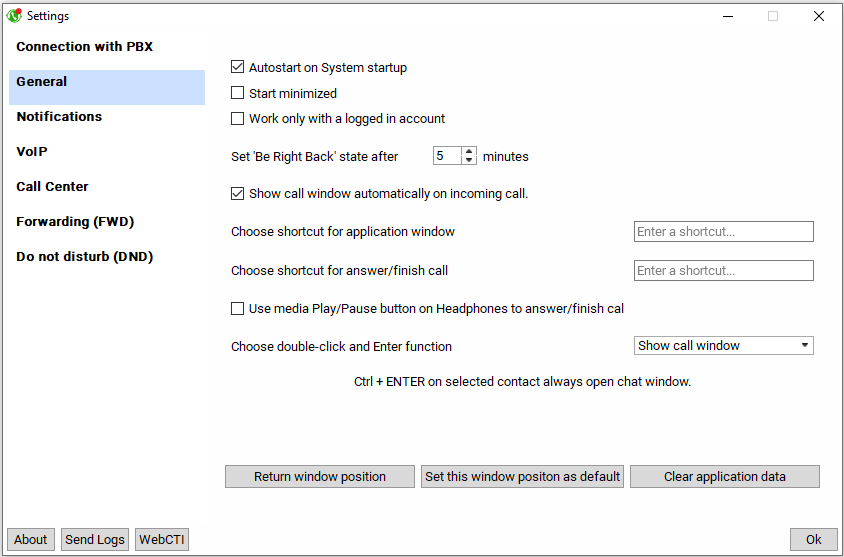
This window allows to configure settings defining how program works and startup options.
Available settings:
- Auto start on System startup - automatic start of application.
- Start minimized - application will run hidden in system task bar.
- Set "Be right back" state after x minutes - status icon will change automatically, informing about user being away from computer after defined time
- Show call window automatically on incoming call - Enables/ disables popup window when there is an incoming call
- Choose shortcut for application window - changes application from Windows task bar to desktop and vice versa
- Choose shortcut for answer/finish call - answer call/ end call with selected keyboard shortcut
- Use media Play/ Pause button on Headphones to answer/finish cal
- Choose double click and Enter function (for contact or number):
- show call window - choice windows is displayed with options - number, phone call, opening chat/SMS window, closing current window
- call primary number - automatic number dialling
- show chat window - opens text chat window
- Return window position - return to previous window position
- Set this window position as default - allows to set up default application's window potion on screen
- Clear application data - deletes all application configuration data, attachments, history
Notifications
These setting allow to set up audio notifications informing about incoming calls, messages and audio setting of computer audio devices.
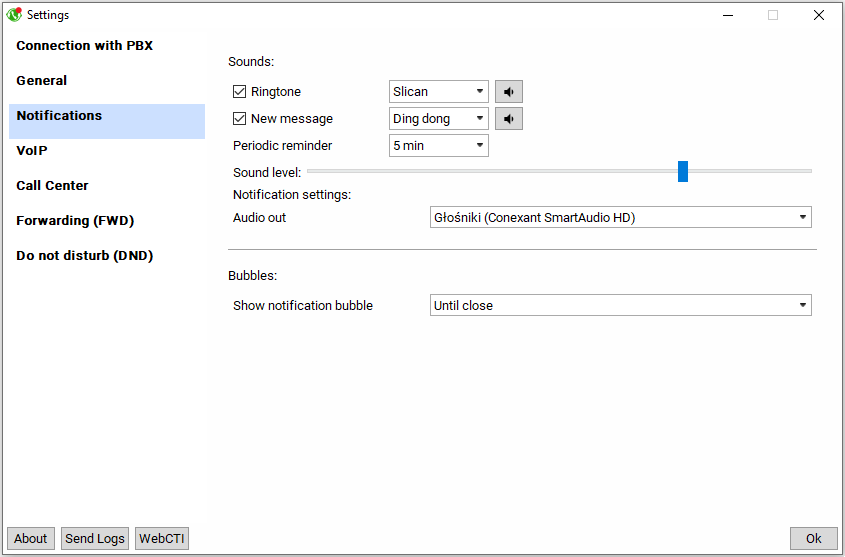
VoIP
- Enable VoIP on when available - allows application to work as VoIP client (VoIP phone). Advanced VoIP settings also allow to connect application with PBX on non-standard ports (e.g. from Internet to client's edge router, MAC PBX)
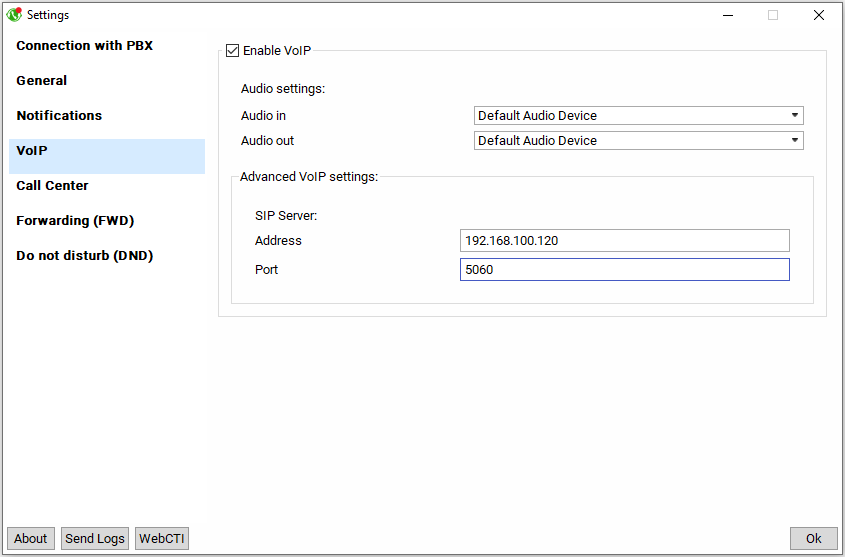
CallCenter
This window allows to configure some options related to agent's handling of CallCenter queues, e.g. buttons for logging in to one, many, all queues, buttons for agent breaks
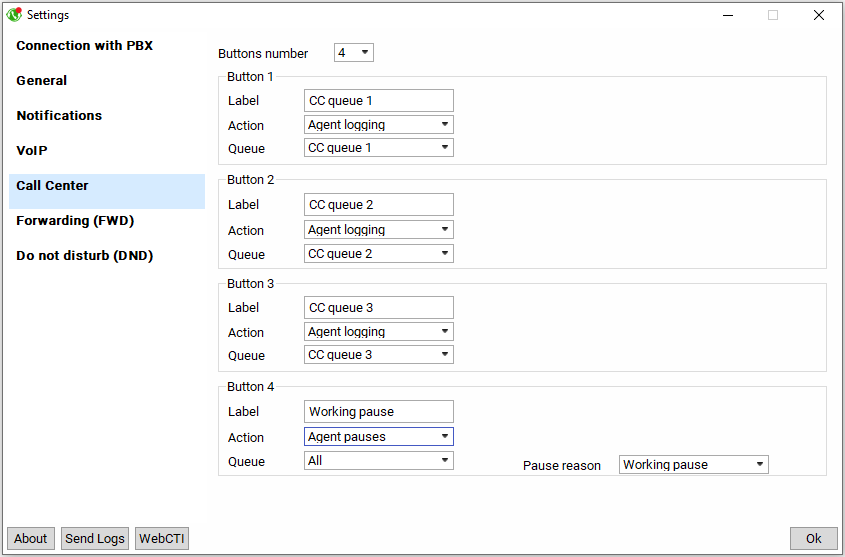
Services management
This window allows to configure Forwardings and DND services
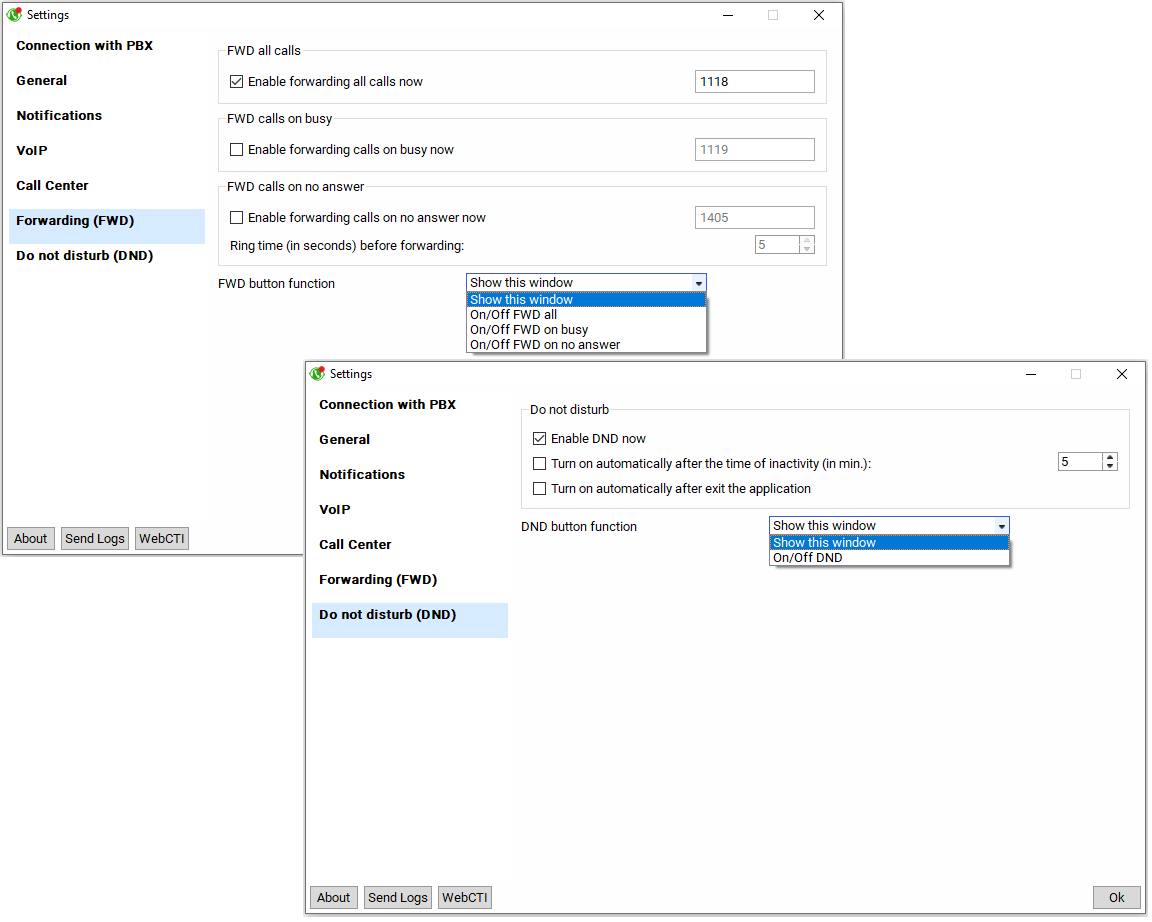
Dialing and picking up calls
To make phone call between two users, particular hardware, software and proper configuration must be supplied:
- Slican PBX
- computer with installed and configured MessengerCTI.Desktop software
- software logged to PBX with subscriber extension (Settings tab, Connection field)
- analog, VoIP or Slican system phone
- for video preview - DPH.IP doorphone with camera or phone associated with external camera (not applicable VoIP phones with integrated camera)
Making and answering phone call can be done using computer mouse and computer screen. Conversation (transmission of acoustics) between subscribers takes place using phone connected to PBX associated with MessengerCTI.Desktop or can be done with application itself - if it's running in VoIP mode.
After dialing required subscriber number from MessengerCTI and initiating connection - in case of:
- CTS system telephone - PBX will activate acoustics on it in hands-free mode and establish call to destination subscriber
- VoIP and analogue telephone - PBX will automatically call back telephone first (notify caller that it is ready for call) and, after picking up handset, it will establish call
- MessengerCTI in VoIP mode (MCTI) - will automatically establish call
Dialing calls to particular number
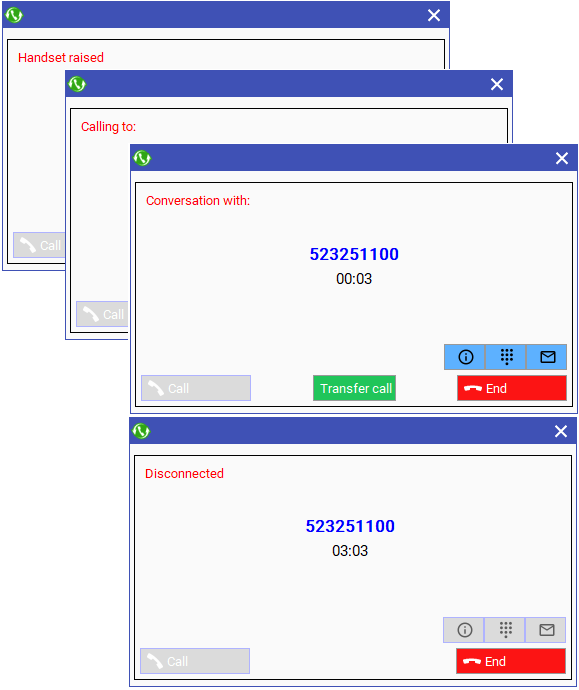
Making calls can be realised in few different way. Depending on how configured are general setting on application - option "Set double click function".
- from Contacts tab
- choose subscriber from proper group (from drop-down list - if it exist) or from group "All contacts" by double clicking on number or contact
- right-click on subscriber from proper group (from drop-down list - if it exist) and then select one of his numbers (associated with contact details)
- clicking on one of icons next to selected contact:


and then, after opening Messages window --> Call button
- using numeric keypad of application
- Search field - by enter telephone number directly using computer keyboard, then click on green icon handset associated with field
- Recent tab - call history:
- we find subscriber call with whom we had contact (he called us or we called him) and then we make call by double clicking on his number or contact
- right-click on call from/ to subscriber with whom we had contact and then select one of his numbers (related to contact details)
- clicking on one of icon by past call


and then, after opening Messages window --> Call button
In version 1.03, possibility of selecting digits in DTMF was introduced. This may be applicable in case of a call to Hotline, where you can navigate through menu on active acoustics.
Exemplary scheme of making call from MessengerCTI directly to another subscriber:
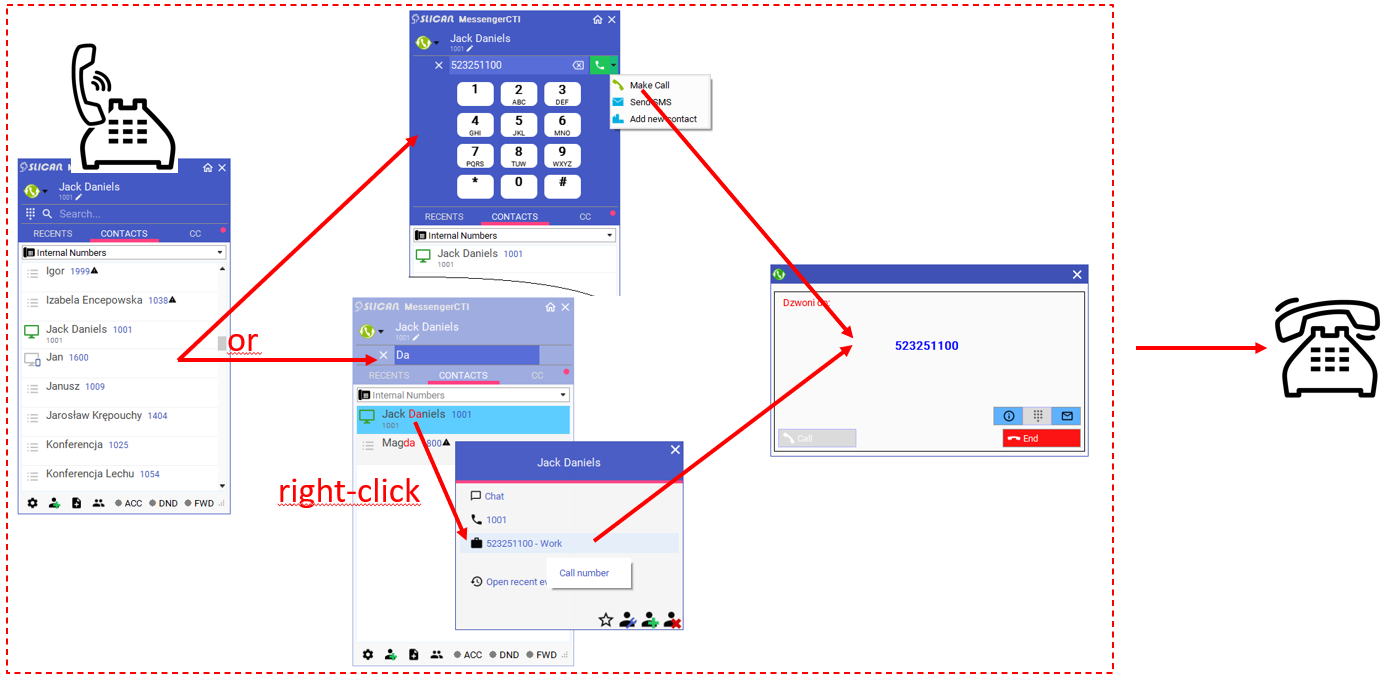
Exemplary scheme of making call from Messenger to hotline:
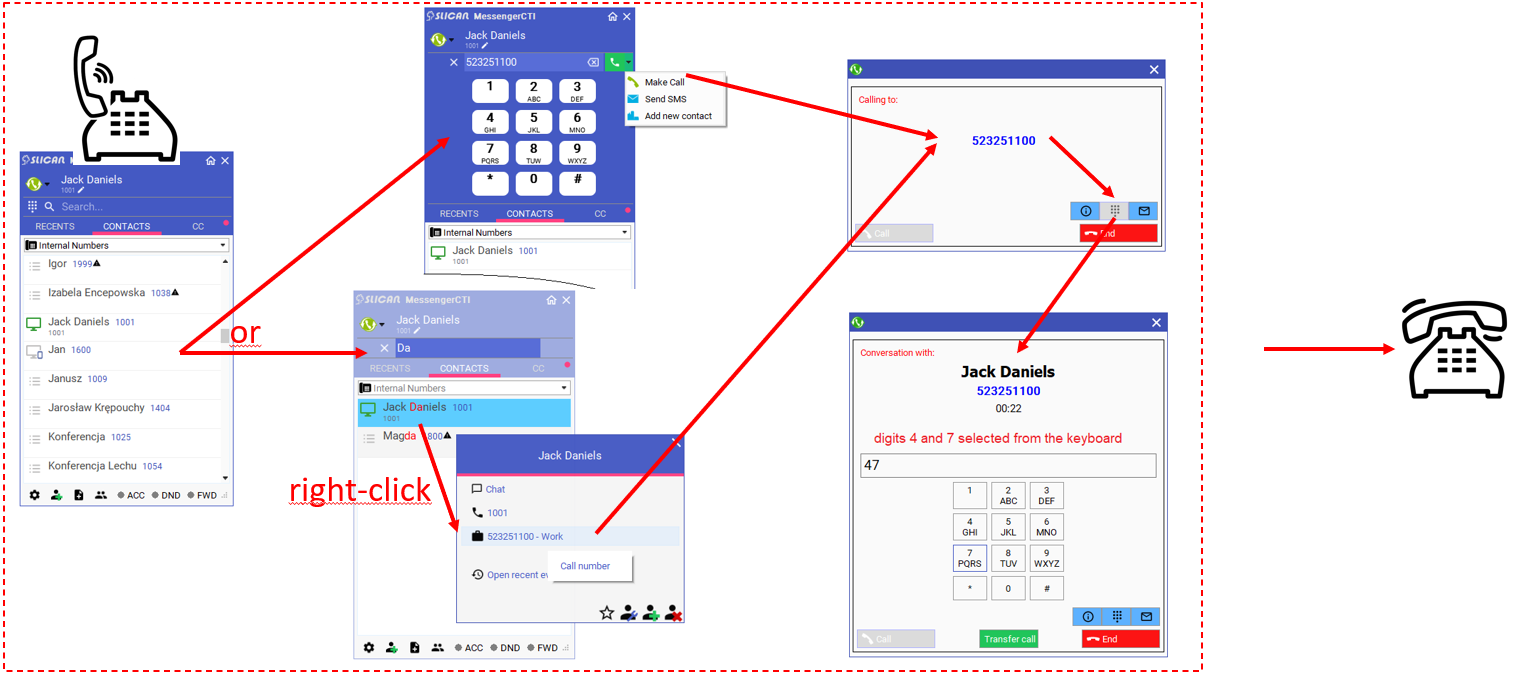
Incoming calls
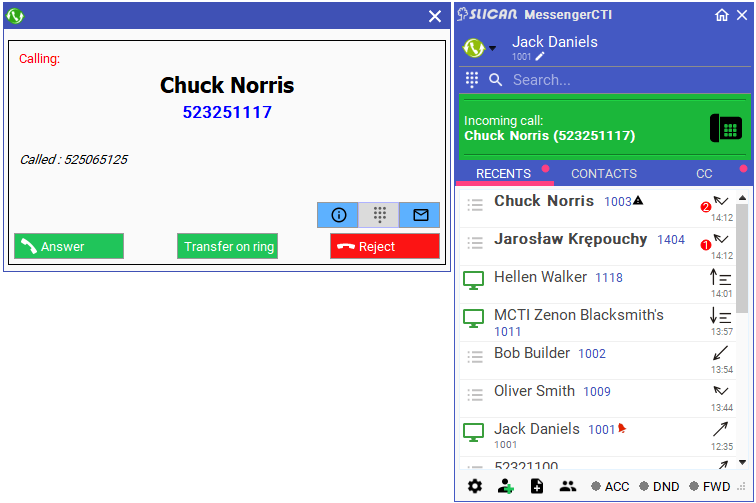
Calls are displayed on computer screen with pop-up window, ringing application and ringing phone. Depending on applied configuration call can be answered, rejected and/ or transferred using application or phone. It is also possible to send text or SMS message back.
Connecting to camera video preview
Connecting to/from DPH.IP with integrated camera or associated phone or external IP camera(doesn't apply to VoIP phone with integrated cameras)will display automatically new window on computer screen. Connecting to doorphone allows to identify visible person and open door/gate with ![]() without picking up call.
without picking up call.
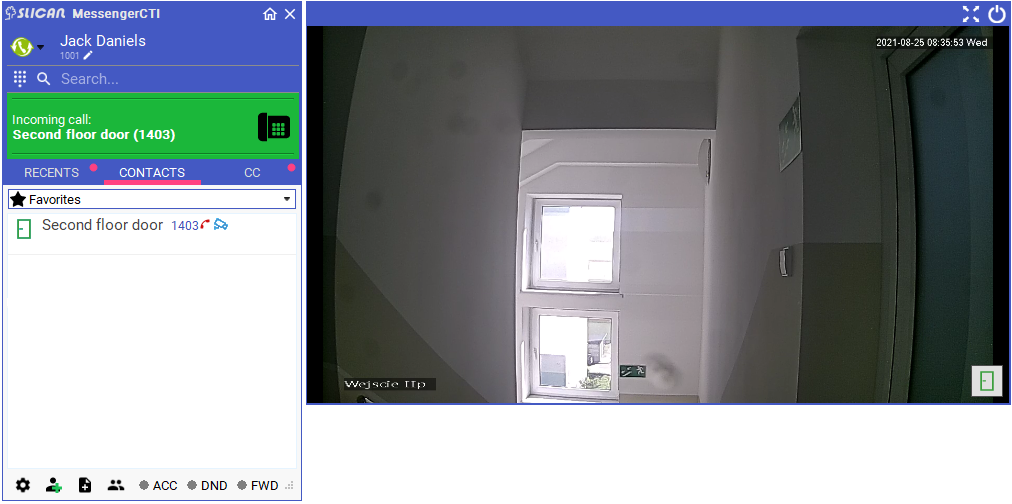
Transfering calls - version 1.07
Call can be transfered by choosing contact or number from: Recent or Contacts.
- "blind transfer" - without checking target extensions state
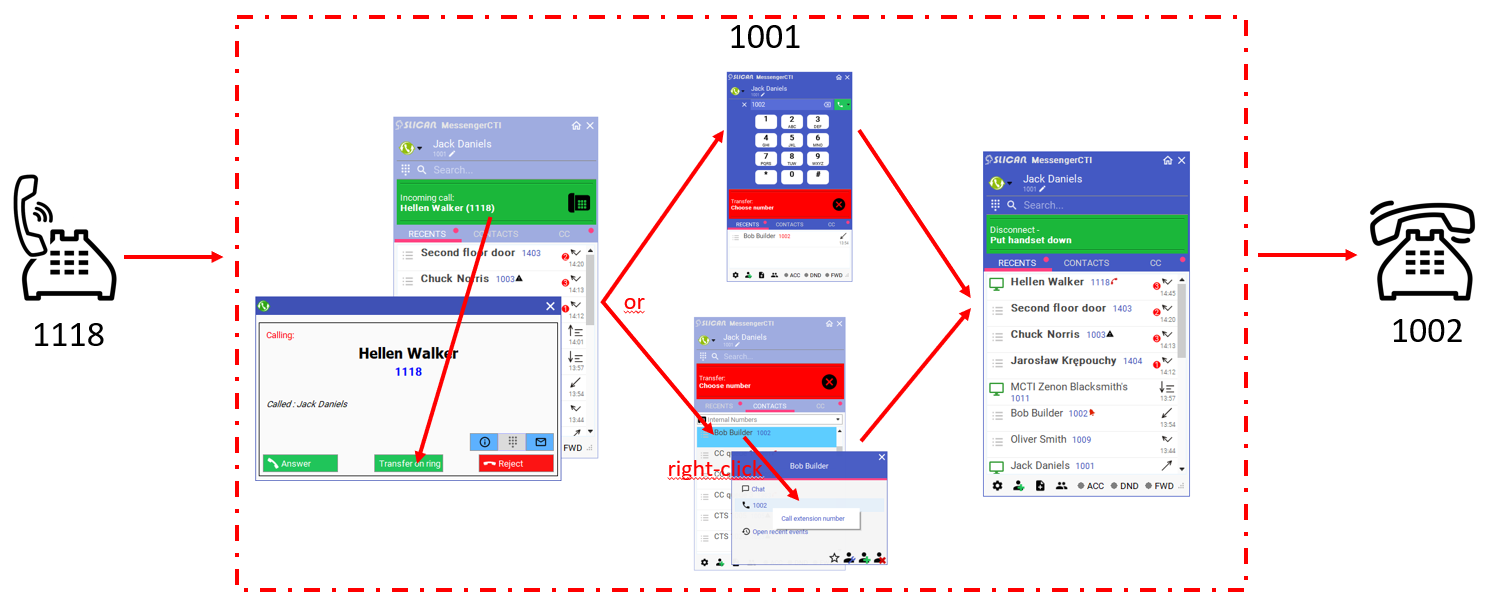
- no announcing - check target extension state without announcing

- with annoucing - check target extension state with announcing
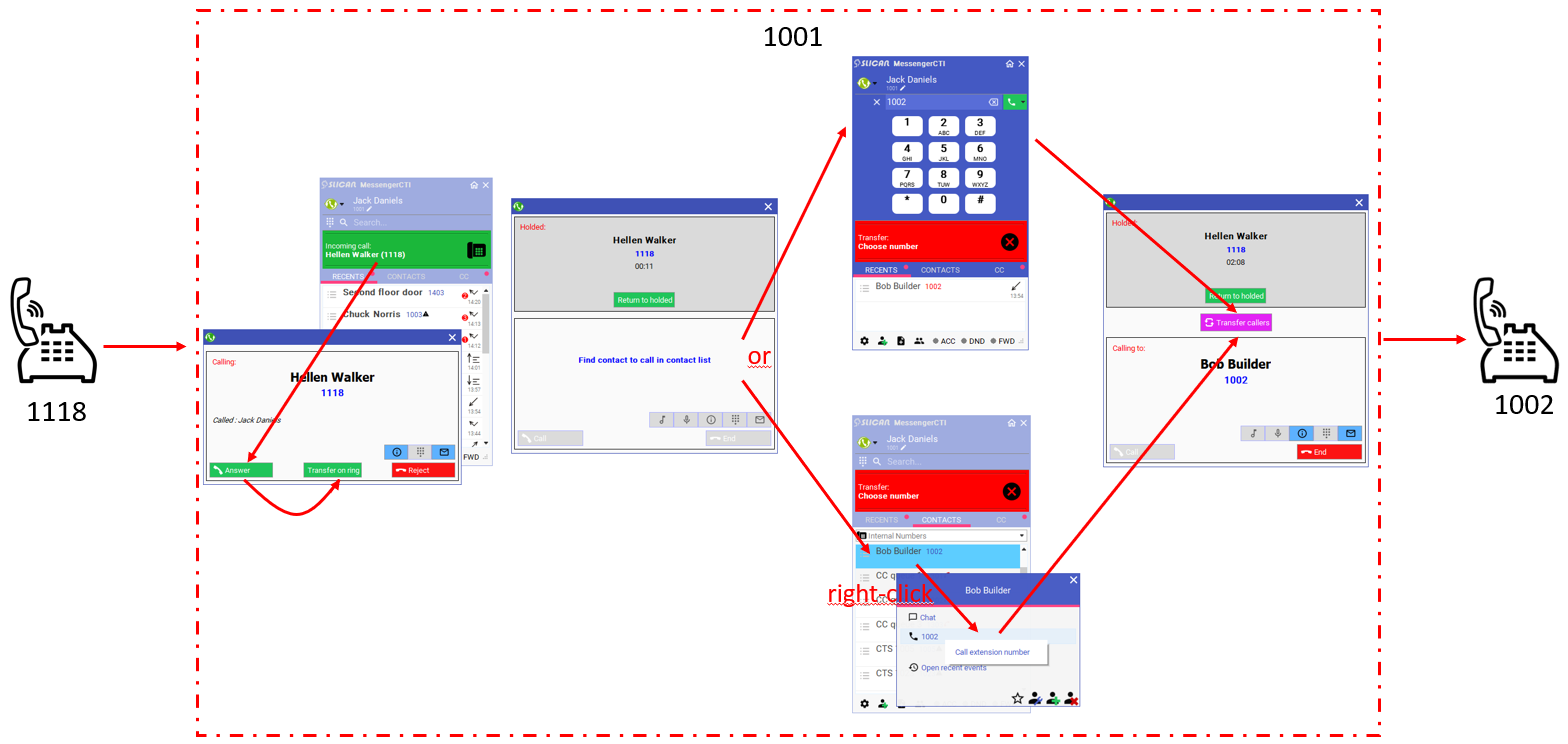
Sending messages
Application allow sending and receiving text messages between application users (internal chat) or by SMS. Message can be sent using ![]()
![]() or by typing GSM number in search field of main application window. If in PBX phone book there is GSM number associated with extension number, user sending message can choose between chat message or SMS.
or by typing GSM number in search field of main application window. If in PBX phone book there is GSM number associated with extension number, user sending message can choose between chat message or SMS.
Functionalities that can be implemented through chat window:
- running text chats between users of MessengerCTI application (desktop and mobile) of same PBX and linked PBX
- sending and receiving SMS
- file transfer (using paperclip button or drag and drop method)
- viewing history calls with given user
- listen to call recordings from calls made (if you have appropriate permissions)
Receving new message is signalised on Windows system task bar with two icons alternating ![]() ,
, ![]() and popping up
and popping up ![]() .
.
Messages history is available through hyper link Load previous. It is stored on computer local hard drive.
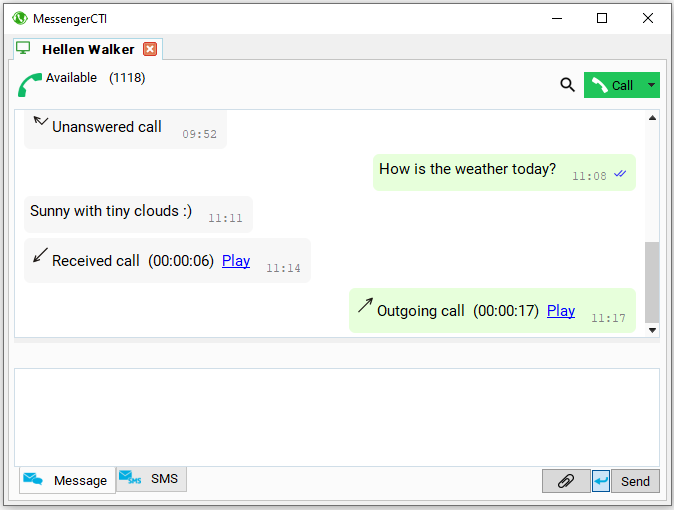
Searching data
MessengerCTI is using advanced way or text search. Searching can be accessed through Recents and Contacts tab in Search:
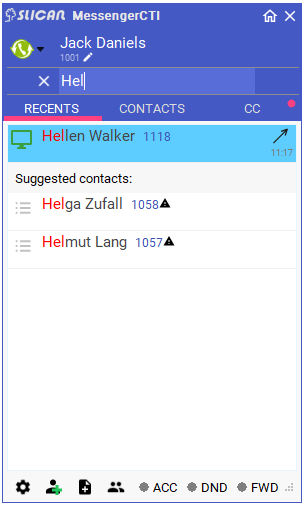
During entering characters/signs in search field, software automatically searches in database. Entries found in subscribers group displayed on left field side will be displayed under it. Entries from other group are classified as Suggested.
Contacts
This field allows for searching, displaying, customising and running actions related to contact. By default Favourites group is displayed. Subscribers from other groups can be accessed by extending groups list with mouse.
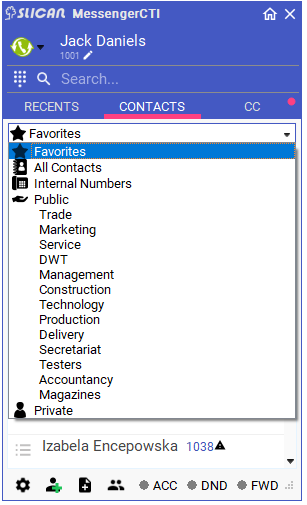
Adding contacts is possible:
- from search field - entering number and adding it with green handset icon
- from Contacts or Recent tab - right clicking on connection
From contact list we gain access to:
- favourites
- all contacts
- extensions
- created subscriber groups
- public contacts
- private contacts
Call history
Choosing Recent tab - in main program window will display call history of currently logged extension to MessengerCTI.Desktop. Window will look like this.
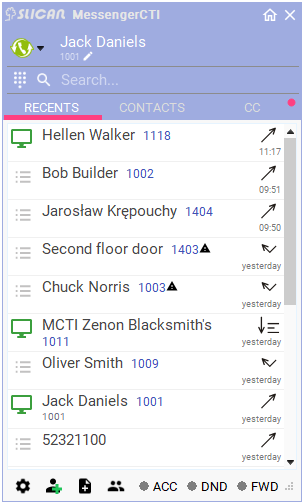
History is displaying all calls associated with logged in extension. Each list segment represents at least one call or message. If same subscriber(number)called/send message more then once, contact status icon will show that number. Each segment is showing caller number, his text status(for outgoing calls - chosen number and text status), length of call or call date and time. For extensions call status is also displayed. Beside text information each line have icon status for each call:
Upward arrow for outgoing call, isn't distinguished between picked up and missed call.
Downward arrow for incoming call that was picked up.
or
Turned arrow for missed incoming calls, digit is showing number of these calls.
Arrow with listed lines or text bubble for text chat or sent SMS. Digit is showing number of missed messages.
If history contains missed calls or unread messages icon in Recent field will be in colour red.
From History window call can be dialled or messages be send to chosen users by right clicking on subscribers text status
, clicking on icons ![]()
![]() and
and
. If internal subscriber have other number listed in their phone book, choice can be made between them. For internal subscribers there is option of editing, deleting contact and deleting from favourite list.
Clipboard
Clipboard is used to transfer messages/ information/ files between MessengerCTI.desktop and MessengerCTI.mobile of same user. When you put file in one application, it automatically appears in other application.
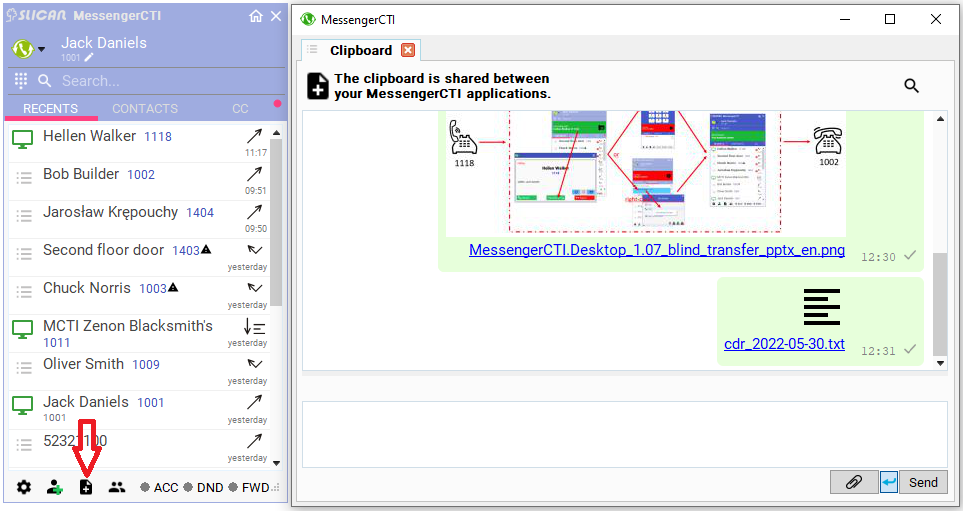
Text conference
Functionality introduced for simultaneous exchange text messages between multiple users. User calling conference selects users to attend. After approval list, message is automatically sent to each of them. After joining conference, sent message is delivered to each user. Each user sees both information exchange and other users participating in conference.
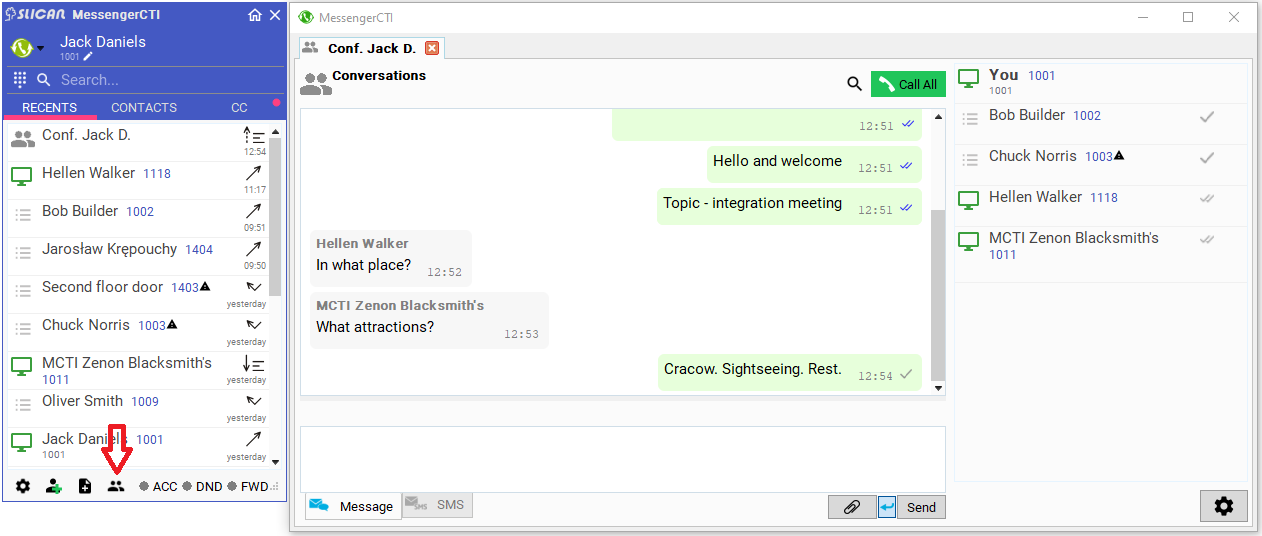
Recall another user's account
This functionality was introduced for users working in same place at different times (e.g. shift work) and using same phones and computers. Logging in with your own account number allows you to later correctly settle each employee's tasks and working time.
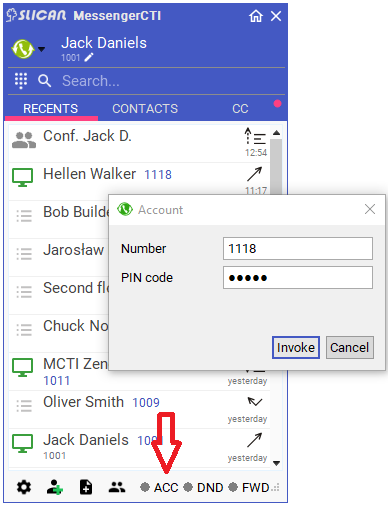
MessengerCTI.Desktop for Call Center agents
From NCP 1.12 firmware NCP and MessengerCTI.Desktop version 1.02, application includes features for servicing Call Center queues. For application user which have Call Center permissions set in PBX - Windows system tool bar will have additional icon Agents status and additional tab CC in application itself.
Application state icons:
Red dot by application state informs about unanswered call or message waiting for user.
Agents state icons:
Red dot by agent state icons informs about calls unanswered by CC agents.
CC tab within application, depending on configuration is showing:
- up to 4 programmed buttons with present state for current agent: Log in/out of CC queue and Turn on/off agent pause
- serviced queues with amount of logged agents and waiting calls
- Callback list - numbers/contacts to call back
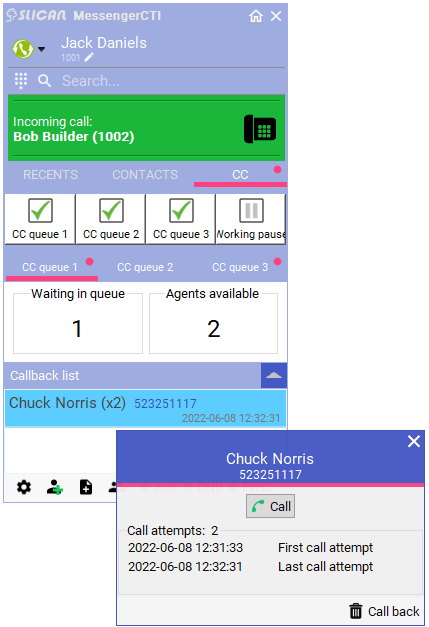
When using callback list, additional window will apear allowing to make call and field to confirm if call was successfull.
To properly configure CC tab, Call Center sections within application preferences must be set up.

Licensing
IPX, MAC, CCT PBX
MessengerCTI.Desktop application:
- ALWAYS MUST be associated with subscriber port, analogue, system or VoIP; for subscriber ports standard licensing applies - for associating with VoIP port, 1 VoIP for subscriber license is necessary.
- for configuration using VoIP functionality (working as parallel phone) there isn't need to associate application with VoIP port, it is application functionality, it can be associated with any type of subscriber port
- calls made form application in VoIP mode are using VoIP channels just like other VoIP devices
- MessengerCTI.Desktop configured without VoIP and camera preview access - CTIuser license is required
- MessengerCTI.Desktop configured with VoIP and camera preview access - CTIuserPlus license is required
NCP PBX
MessengerCTI.Desktop:
- CAN be associated with any subscriber port - analogue, system or VoIP; each subscriber port is treated as 1 user from Base license, additionally while associating application with VoIP port 1 NCP.VoIPuser license is neccesary
- for configuration using VoIP functionality (working as parallel phone) there isn't need to associate application with VoIP port, it is application functionality, it can be associated with any type of subscriber port
- MessengerCTI.Desktop configured without VoIP and camera preview access - NCP.CTIuser license is required
- MessengerCTI.Desktop configured with VoIP and camera preview access - NCP.CTIuserPlus license is required
- MessengerCTI.Desktop as standalone subscriber - MCTI (not associated with subscriber port):
- MessengerCTI.Desktop with VoIP funcionality and camera preview access - NCP.VoIPuser and NCP.CTIuserPlus licenses are required
One user and few different numbers
Sometimes one computer use must operate with few different extensions numbers. On workstation (computer) use of "instance" is neccesary. Application has to be installed (just once). User must prepare shortcuts containing extra parameters that will allow to create seperate configuration.
- default location of program instalation is: C:\Program Files (x86)\Slican\MessengerCTI\messengercti.exe
- if program can't be found in default location, Windows search option or through Start Menu. For Windows 10, open Start Menu, search for Slican directory, in directory look for MessengerCTI, right click -> More/ Open File Location - program icon will appear, right click -> Properties/Shortcut/Target
- create program shortcut on desktop
- in shortcut properties add instance - Properties/Shortcut/Target: "C:\Program Files (x86)\Slican\MessengerCTI\messengercti.exe" -instance 1
- create as many copies of shortcut as needer for user, in each next one change instance digit for next number, for example: -instance 2, -instance 3, ...
- while running aplication from shortcuts we can configure each one seperatly for different numbers
Ports and protocols
Default port numbers and types of protocols used by PBX for purpose of providing selected services of MessengerCTI application.
Basic:
- signaling
- 5529 TCP - application signaling (XML)
- 5543 TCP - signaling in mode with enabled encryption tag (XML)
- VoIP calls
- 5060 UDP - SIP signaling (for VoIP calls)
- 8100 - 8300 UDP - acoustics - for IPx, CCT, MAC PBX
- 10000 - 20000 UDP - acoustics - for NCP PBX
Additional:
- file transfer - NCP only (clipboard, between users):
- 443 TCP - file transmission without encryption tag enabled (transmission is still HTTPS encrypted)
- 5543 TCP - file transmission in mode with enabled encryption tag
- image transmission from DPH.IP doorphone camera
- location of link to camera in PBX:
- NCP: Extensions/ Devices/ Cameras
- IPx, MAC, CCT: Peripherals/ Cameras
- during connection, PBX sends camera link to MessengerCTI application: rtsp://IP_addr_camera:554/login_password_additional_information
- location of link to camera in PBX:
Example for NCP for MessengerCTI working from outside PBX IP network (configuration in ConfigWEB):
- XML signaling, VoIP, file transmission - Extensions/ Settings/ Informations about CTI settings for subscribers and applications tab
- sending image from camera (link to camera, linking camera with DPH.IP) - tab Extensions/ Devices/ Cameras
Sample configuration data:
- IP PBX address: 192.168.0.10
- public IP router address: 222.0.0.1
- domain address: company_name.com
- IP camera address: 192.168.0.20
- ports used to redirect individual services on router: 55xx
XML signaling:
- MessengerCTI --> router --> NCP
- MessengerCTI --> 222.0.0.1:5555 --> 192.168.0.10:5529, or
- MessengerCTI --> company_name.com:5555 --> 192.168.0.10:5529
XML signaling with encryption tag enabled:
- MessengerCTI --> 222.0.0.1:5558 --> 192.168.0.10:5543, or
- MessengerCTI --> company_name.com:5558 --> 192.168.0.10:5543
VoIP calls (signaling)
- MessengerCTI --> 222.0.0.1:5556 --> 192.168.0.10:5060
- MessengerCTI --> company_name.com:5556 --> 192.168.0.10:5060
VoIP calls (acoustics)
- MessengerCTI --> 222.0.0.1:10000 - 222.0.0.1:20000 --> 192.168.0.10:10000 - 192.168.0.10:20000
- MessengerCTI --> company_name.com:10000 - company_name.com:20000 --> 192.168.0.10:10000 - 192.168.0.10:20000
File transfer:
- MessengerCTI --> 222.0.0.1:5557 --> 192.168.0.10:443, or
- MessengerCTI --> company_name.com:5557 --> 192.168.0.10:443
File transfer with encryption tag enabled:
- MessengerCTI --> 222.0.0.1:5559 --> 192.168.0.10:5543, or
- MessengerCTI --> company_name.com:5559 --> 192.168.0.10:5543
Image transferring from DPH.IP camera
- MessengerCTI --> router --> camera
- MessengerCTI --> 222.0.0.1:5560 --> 192.168.0.20:554
- MessengerCTI --> company_name.com:5560 --> 192.168.0.20:554.
Operation of MessengerCTI.Desktop in local network and outside network without changing configuration
Changing network source by MessengerCTI.desktop or MessengerCTI.mobile user (e.g. LAN <--> Internet <--> LAN, workplace <--> travel <--> home) always entails need to change application configuration, i.e. change IP address of PBX from local to public or vice versa.
In order to simplify operation and configuration of MessengerCTI application, you can use functionality offered by many network routers.
It allows device with MessengerCTI (computer, smartphone) connect to PBX, regardless of whether it is in local network (LAN, WiFi) or outside it (other sub-networks, Internet, GSM-LTE). In routers, this functionality is called NAT hairpinning, NAT loopback or NAT reflection. It allows access to PBX service via public IP address, regardless of range of network user is currently in.
Sample network:
- router's public address (WAN on router): decimal address - 203.0.113.1 or domain address - voip.xxxxxx.com
- router's local address (LAN on router, gateway): 192.168.1.1
- LAN PBX address (NCP, IPx, MAC, CCT): 192.168.1.2
- LAN IP address user's notebook with MessengerCTI.Desktop or smartphone with MessengerCTI.Mobile: 192.168.1.100
If MessengerCTI on notebook/ smartphone from local network IP: 192.168.1.100 sends packets to public address 203.0.113.1 (voip.xxxxxx.com), packets are routed to default gateway - 192.168.1.1 (router). NAT hairpinning router detects that 203.0.113.1 (voip.xxxxxx.com) is address of its WAN interface and treats that packets as if it came from that interface. Determines destination for this packets based on DNAT rules (port forwarding). If packets has been sent to port 5529 (for VoIP: 5060, 8100-8300 IPx, 10,000 - 20,000 NCP) and there is DNAT rule for this port directed to 192.168.1.2, then PBX receives packets at this address.
If appropriate DNAT rules exist, address translation is performed - router rewrites source local IP address in within packet to public address. Notebook/ smartphone (192.168.1.100) sends packets, but PBX (192.168.1.2) receives it as coming from 203.0.113.1. When PBX responds, process is same as for notebook/ smartphone. In this way, two-way communication between notebook/ smartphone in LAN via a public IP address is possible.
If no DNAT rules are active, router will discard packets. In this case, it may return an ICMP Destination Unreachable reply.
